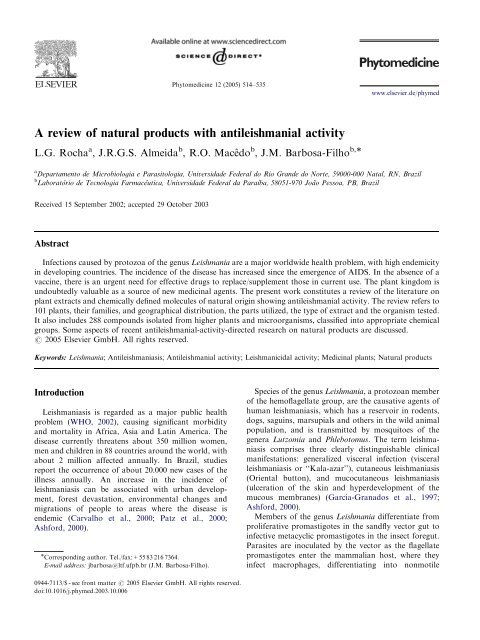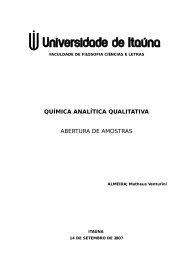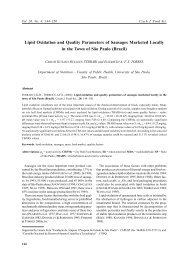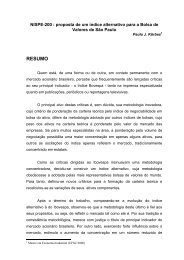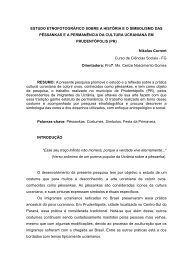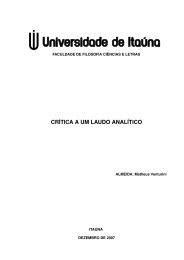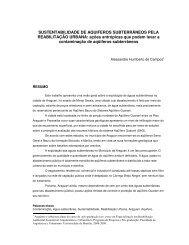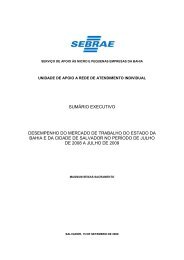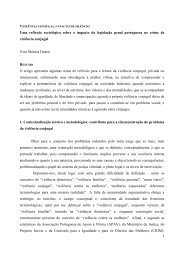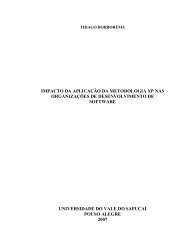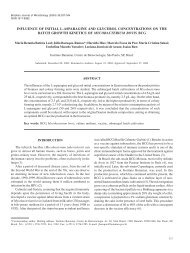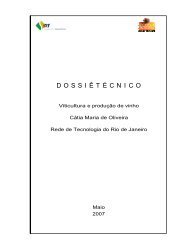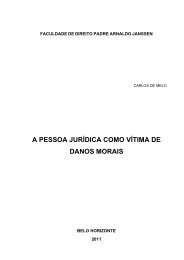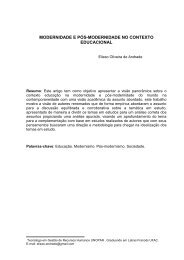A review of natural products with antileishmanial activity
A review of natural products with antileishmanial activity
A review of natural products with antileishmanial activity
Create successful ePaper yourself
Turn your PDF publications into a flip-book with our unique Google optimized e-Paper software.
Phytomedicine 12 (2005) 514–535<br />
A <strong>review</strong> <strong>of</strong> <strong>natural</strong> <strong>products</strong> <strong>with</strong> <strong>antileishmanial</strong> <strong>activity</strong><br />
L.G. Rocha a , J.R.G.S. Almeida b , R.O. Maceˆ do b , J.M. Barbosa-Filho b,<br />
a Departamento de Microbiologia e Parasitologia, Universidade Federal do Rio Grande do Norte, 59000-000 Natal, RN, Brazil<br />
b Laboratório de Tecnologia Farmacêutica, Universidade Federal da Paraíba, 58051-970 João Pessoa, PB, Brazil<br />
Received 15 September 2002; accepted 29 October 2003<br />
Abstract<br />
Infections caused by protozoa <strong>of</strong> the genus Leishmania are a major worldwide health problem, <strong>with</strong> high endemicity<br />
in developing countries. The incidence <strong>of</strong> the disease has increased since the emergence <strong>of</strong> AIDS. In the absence <strong>of</strong> a<br />
vaccine, there is an urgent need for effective drugs to replace/supplement those in current use. The plant kingdom is<br />
undoubtedly valuable as a source <strong>of</strong> new medicinal agents. The present work constitutes a <strong>review</strong> <strong>of</strong> the literature on<br />
plant extracts and chemically defined molecules <strong>of</strong> <strong>natural</strong> origin showing <strong>antileishmanial</strong> <strong>activity</strong>. The <strong>review</strong> refers to<br />
101 plants, their families, and geographical distribution, the parts utilized, the type <strong>of</strong> extract and the organism tested.<br />
It also includes 288 compounds isolated from higher plants and microorganisms, classified into appropriate chemical<br />
groups. Some aspects <strong>of</strong> recent <strong>antileishmanial</strong>-<strong>activity</strong>-directed research on <strong>natural</strong> <strong>products</strong> are discussed.<br />
r 2005 Elsevier GmbH. All rights reserved.<br />
Keywords: Leishmania; Antileishmaniasis; Antileishmanial <strong>activity</strong>; Leishmanicidal <strong>activity</strong>; Medicinal plants; Natural <strong>products</strong><br />
Introduction<br />
Leishmaniasis is regarded as a major public health<br />
problem (WHO, 2002), causing significant morbidity<br />
and mortality in Africa, Asia and Latin America. The<br />
disease currently threatens about 350 million women,<br />
men and children in 88 countries around the world, <strong>with</strong><br />
about 2 million affected annually. In Brazil, studies<br />
report the occurrence <strong>of</strong> about 20.000 new cases <strong>of</strong> the<br />
illness annually. An increase in the incidence <strong>of</strong><br />
leishmaniasis can be associated <strong>with</strong> urban development,<br />
forest devastation, environmental changes and<br />
migrations <strong>of</strong> people to areas where the disease is<br />
endemic (Carvalho et al., 2000; Patz et al., 2000;<br />
Ashford, 2000).<br />
Corresponding author. Tel./fax:+55 83 216 7364.<br />
E-mail address: jbarbosa@ltf.ufpb.br (J.M. Barbosa-Filho).<br />
ARTICLE IN PRESS<br />
0944-7113/$ - see front matter r 2005 Elsevier GmbH. All rights reserved.<br />
doi:10.1016/j.phymed.2003.10.006<br />
www.elsevier.de/phymed<br />
Species <strong>of</strong> the genus Leishmania, a protozoan member<br />
<strong>of</strong> the hem<strong>of</strong>lagellate group, are the causative agents <strong>of</strong><br />
human leishmaniasis, which has a reservoir in rodents,<br />
dogs, saguins, marsupials and others in the wild animal<br />
population, and is transmitted by mosquitoes <strong>of</strong> the<br />
genera Lutzomia and Phlebotomus. The term leishmaniasis<br />
comprises three clearly distinguishable clinical<br />
manifestations: generalized visceral infection (visceral<br />
leishmaniasis or ‘‘Kala-azar’’), cutaneous leishmaniasis<br />
(Oriental button), and mucocutaneous leishmaniasis<br />
(ulceration <strong>of</strong> the skin and hyperdevelopment <strong>of</strong> the<br />
mucous membranes) (Garcia-Granados et al., 1997;<br />
Ashford, 2000).<br />
Members <strong>of</strong> the genus Leishmania differentiate from<br />
proliferative promastigotes in the sandfly vector gut to<br />
infective metacyclic promastigotes in the insect foregut.<br />
Parasites are inoculated by the vector as the flagellate<br />
promastigotes enter the mammalian host, where they<br />
infect macrophages, differentiating into nonmotile
amastigotes and multiplying as such (Arau´ jo et al., 1998;<br />
Carvalho et al., 2000). The mechanisms by which<br />
visceral and cutaneous manifestations develop have<br />
not been fully clarified.<br />
The treatment <strong>of</strong> leishmaniasis is difficult because <strong>of</strong><br />
the intramacrophagic location <strong>of</strong> the infectious form.<br />
Victims <strong>of</strong> this illness present an immune deficiency and<br />
are not able to eliminate the parasites through a <strong>natural</strong><br />
mechanism <strong>of</strong> defense. Moreover, malnutrition is<br />
associated <strong>with</strong> certain cases <strong>of</strong> leishmaniasis. Parallel<br />
infection <strong>with</strong> diseases such as malaria and pneumonia<br />
increases the fatality <strong>of</strong> the illness if it is not diagnosed<br />
and treated in time. The problem <strong>of</strong> leishmaniasis has<br />
been worsened by the evolution <strong>of</strong> AIDS due to parallel<br />
infections in AIDS patients, as well as by the development<br />
<strong>of</strong> drug-resistance by parasites (Carvalho et al.,<br />
2000; Torres-Santos et al., 1999).<br />
In the absence <strong>of</strong> a vaccine, there is an urgent need for<br />
effective drugs to replace/supplement those in current<br />
use. The clinically used drugs, many <strong>of</strong> which are based<br />
on pentavalent antimony compounds, were developed<br />
before 1959. The toxicity <strong>of</strong> these agents and the<br />
persistence <strong>of</strong> side-effects even after modification <strong>of</strong><br />
the dose level and duration <strong>of</strong> treatment are, however,<br />
severe drawbacks. The search for <strong>antileishmanial</strong> agents<br />
has been exhaustive. Alternative drugs, such as amphotericin<br />
B and pentamidine, also have unpleasant sideeffects<br />
(Balana et al., 1998; Carvalho et al., 2000). On<br />
the other hand, plant extracts or plant-derived compounds<br />
are likely to provide a valuable source <strong>of</strong> new<br />
medicinal agents (Carvalho and Ferreira, 2001; Kayser<br />
and Kiderlen, 2001) and the urgent need for alternative<br />
treatments has led to a program to screen <strong>natural</strong><br />
<strong>products</strong> for potential use in the therapy <strong>of</strong> leishmaniasis.<br />
In fact, the WHOadvocated the use <strong>of</strong> traditional<br />
medicine where appropriate health services are inaccessible<br />
(Tahir et al., 1998; Weniger et al., 2001; Bhadra,<br />
1993).<br />
Furthermore, the leads obtained from the search for<br />
<strong>natural</strong> <strong>products</strong> <strong>with</strong> antileshmanial <strong>activity</strong> give new<br />
impetus for obtaining valuable synthetic compounds<br />
(Carvalho et al., 2000).<br />
With the objective <strong>of</strong> contributing to these studies, a<br />
literature search on the use <strong>of</strong> <strong>natural</strong> <strong>products</strong> (crude<br />
plant extracts, semi-purified fractions and chemically<br />
defined molecules) which have already been evaluated<br />
particularly for leishmaniasis, has been carried out.<br />
Materials and methods<br />
The keywords used for the literature search<br />
for this <strong>review</strong> were Leishmania antileishmaniasis<br />
<strong>antileishmanial</strong> <strong>activity</strong> leishmanicidal <strong>activity</strong><br />
medicinal plants <strong>natural</strong> <strong>products</strong>. The search was<br />
ARTICLE IN PRESS<br />
L.G. Rocha et al. / Phytomedicine 12 (2005) 514–535 515<br />
carried out using Biological Abstracts, Chemical<br />
Abstracts, and the data bank <strong>of</strong> the University <strong>of</strong><br />
Illinois in Chicago NAPRALERT (Acronym for NAtural<br />
PRoducts ALERT), updated to December 2001.<br />
The references found in the search were then studied in<br />
detail.<br />
Results and discussion<br />
Consultation <strong>of</strong> various literature sources resulted in<br />
the elaboration <strong>of</strong> a list <strong>of</strong> <strong>natural</strong> <strong>products</strong> evaluated<br />
for <strong>antileishmanial</strong> <strong>activity</strong> (Tables 1 and 2). It should be<br />
noted that most <strong>of</strong> the references cited are not first-hand<br />
observations, but compilations copied from other<br />
sources. For details on the models or mechanism-based<br />
bioassays utilized for selecting crude plant extracts,<br />
fractions and pure compounds against the Leishmania<br />
parasite, the original references should be consulted.<br />
Antileishmanial <strong>activity</strong> <strong>of</strong> crude plant extracts and<br />
fractions<br />
A plant-screening program for potential leishmanicides<br />
was initiated in 1984 in French Guiana, based on<br />
the ethnomedical knowledge <strong>of</strong> the local population.<br />
The leishmanicidal <strong>activity</strong> <strong>of</strong> several plant extracts was<br />
evaluated in vitro, by testing on amastigote stages <strong>of</strong><br />
Leishmania amazonensis, and in vivo using cutaneous L.<br />
amazonensis lesions in mice. Among the selected species,<br />
Faramea guianensis showed <strong>activity</strong> (Sauvain et al.,<br />
1994).<br />
Fourteen plants used topically in folk medicine in<br />
Bolivia to treat cutaneous leishmaniasis were collected<br />
in the tropical regions <strong>of</strong> colonization and in the rain<br />
forest occupied by Chimane Indians. Two plants<br />
employed by those in the colonial region showed an in<br />
vitro <strong>antileishmanial</strong> <strong>activity</strong>: Bocconia integrifolia and<br />
B. pearcei. Three other plants, Ampelocera edentula,<br />
Galipea longiflora and Pera benensis, employed by<br />
Chimane Indians, were effective in mice infected <strong>with</strong><br />
L. amazonensis (Fournet et al., 1994b).<br />
A preliminary examination <strong>of</strong> the crude methanol<br />
extracts <strong>of</strong> eight plant species collected from the Sudan<br />
revealed that only three plant species had a considerable<br />
in vitro <strong>antileishmanial</strong> <strong>activity</strong> on L. major promastigotes<br />
at a concentration o0.5 mg/ml. The plants<br />
Azadirachta indica, Maytenus senegalensis and Eucalyptus<br />
globulus showed IC50 values <strong>of</strong> 11.5, 55 and 78 mg/ml,<br />
respectively (Tahir et al., 1998).<br />
Singha et al. (1992) evaluated a total <strong>of</strong> 23 plants from<br />
Madras, India, for <strong>antileishmanial</strong> <strong>activity</strong>, <strong>with</strong> L.<br />
donavani infected hamsters. Extracts derived from five<br />
plants (viz., Alstonia scholaris, Swertia chirata, Tibouchina<br />
semidecandra, Tinospora cordifolia and Nyctanthes
Table 1. Plant extracts summary showing <strong>antileishmanial</strong> <strong>activity</strong> a<br />
Family and botanical name Origin Part used Organism tested Preparation b<br />
Agavaceae<br />
Yucca filamentosa L. Germany<br />
c<br />
Reference<br />
L. amazonensis Ethanol extract Plock et al. (2001)<br />
Annonaceae<br />
Annona glauca Thonn. Senegal SD L. amazonensis Dichloromethane ext Waechter et al. (1998)<br />
L. braziliensis Dichloromethane ext Waechter et al. (1998)<br />
L. donovani Dichloromethane ext Waechter et al. (1998)<br />
Annona muricata L. Colombia PE L. braziliensis Ethyl acetate extract Jaramillo et al. (2000)<br />
L. panamensis Ethyl acetate extract Jaramillo et al. (2000)<br />
Annona senegalensis Pers Senegal SD Leishmania sp. Dichloromethane ext Sahpaz et al. (1996)<br />
Annona aff. spraguei Saff. Colombia SD L. braziliensis Chlor<strong>of</strong>orm extract Saez et al. (1998)<br />
L. infantum Chlor<strong>of</strong>orm extract Saez et al. (1998)<br />
L. panamensis Chlor<strong>of</strong>orm extract Saez et al. (1998)<br />
Cardiopetalum calophyllum Schldl. Bolivia LF+SM L. amazonensis Alkaloid fraction Fournet et al. (1994b)<br />
L. braziliensis Alkaloid fraction Fournet et al. (1994b)<br />
L. donovani Alkaloid fraction Fournet et al. (1994b)<br />
Duguetia spixiana Mart. Bolivia SB L. amazonensis Alkaloid fraction Fournet et al. (1994b)<br />
L. braziliensis Alkaloid fraction Fournet et al. (1994b)<br />
L. donovani Alkaloid fraction Fournet et al. (1994b)<br />
Guatteria foliosa Benth Bolivia SB L. amazonensis Alkaloid fraction Mahiou et al. (1994)<br />
L. braziliensis Alkaloid fraction Mahiou et al. (1994)<br />
L. donovani Alkaloid fraction Mahiou et al. (1994)<br />
Guatteria schoburgkiana Mart. Bolivia RB L. amazonensis Alkaloid fraction Fournet et al. (1994b)<br />
L. braziliensis Alkaloid fraction Fournet et al. (1994b)<br />
L. donovani Alkaloid fraction Fournet et al. (1994b)<br />
Oxandra espintana (Spruce) Baillon Bolivia SB L. amazonensis Alkaloid fraction Fournet et al. (1994b)<br />
L. braziliensis Alkaloid fraction Fournet et al. (1994b)<br />
L. donovani Alkaloid fraction Fournet et al. (1994b)<br />
Xylopia aromatica (Lam.) Mart. Bolivia LF+SB L. amazonensis Alkaloid fraction Fournet et al. (1994b)<br />
L. braziliensis Alkaloid fraction Fournet et al. (1994b)<br />
L. donovani Alkaloid fraction Fournet et al. (1994b)<br />
Apocynaceae<br />
Alstonia scholaris R. Br. India SM L. donovani Ethanol extract Singha et al. (1992)<br />
Holarrhena curtisii King & Gamble Malaysia LF L. donovani Ethanol extract Kam et al. (1998)<br />
Mandevilla antennacea K. Schum. Bolivia LF+SM L. amazonensis Ethanol extract Fournet et al. (1994b)<br />
L. braziliensis Ethanol extract Fournet et al. (1994b)<br />
Peschiera australis Miers. Brazil SM L. amazonensis Chlor<strong>of</strong>orm extract Delorenzi et al. (2001)<br />
Peschiera var. heurkii (Muell. Arg.) L. Allorge Bolivia LF L. amazonensis Ethanol extract Munoz et al. (1994)<br />
L. braziliensis Ethanol extract Munoz et al. (1994)<br />
Picralima nitida Th. & H. Dur. Nigeria SD L. donovani Chlor<strong>of</strong>orm extract Iwu et al. (1992)<br />
Tabernaemontana obliqua (Miers) Leenwenb. Colombia LF L. amazonensis Methanol extract Weniger et al. (2001)<br />
Araliaceae<br />
Hedera helix L. Spain LF L. amazonensis Ethanol extract Fournet et al. (1994b)<br />
516<br />
L.G. Rocha et al. / Phytomedicine 12 (2005) 514–535<br />
ARTICLE IN PRESS
Oreopanax species Bolivia LF L. braziliensis Ethanol extract Fournet et al. (1994b)<br />
Asclepiadaceae<br />
Gongronema latifolia Benth Nigeria LF L. donovani Methanol extract Iwu et al. (1992)<br />
Periploca graeca L. Turkey TG L. major Methanol extract Demirci et al. (1998)<br />
Asteraceae<br />
Acanthospermum hispidum DC. Bolivia EP L. amazonensis Ethanol extract Fournet et al. (1994b)<br />
L. braziliensis Ethanol extract Fournet et al. (1994b)<br />
Achyrocline flaccida (Weinm.) DC. Bolivia EP L. braziliensis Ethanol extract Fournet et al. (1994b)<br />
Ageratina pentlandiana (DC.) K. & R. Bolivia LF L. amazonensis Ethanol extract Fournet et al. (1994b)<br />
L. braziliensis Ethanol extract. Lockman et al. (1991)<br />
Artemisia herba-alba Asso. Maroc<br />
c<br />
L. tropica Aqueous extract Hatimi et al. (2001)<br />
Baccharis salicifolia (R. & P.) Pers. Bolivia LF L. braziliensis Ethyl acetate extract Fournet et al. (1994b)<br />
Chersodoma jodopappa (Sch. Bip.) Cabrera Bolivia LF+SM L. amazonensis Ethanol extract Fournet et al. (1994b)<br />
L. braziliensis Ethanol extract Fournet et al. (1994b)<br />
L. donovani Ethanol extract Fournet et al. (1994b)<br />
Cnicothamnus lorentzii Griseb. Bolivia LF+SM L. amazonensis Ethanol extract Fournet et al. (1994b)<br />
L. donovani Ethanol extract Fournet et al. (1994b)<br />
L. braziliensis Ethanol extract Fournet et al. (1994b)<br />
Echinacea purpurea Moench Germany EP Leishmania sp. Sap Parnham (1996)<br />
Inula montana L. Spain AP L. infantum Methanol Martin et al. (1998)<br />
Jasonia glutinosa DC. Spain AP L. donovani Acetone extract Villaescusa et al. (1996)<br />
Munnozia fournetii H. Robinson Bolivia LF+SM L. amazonensis Ethanol extract Fournet et al. (1994b)<br />
L. braziliensis Ethanol extract Fournet et al. (1994b)<br />
L. donovani Ethanol extract Fournet et al. (1994b)<br />
Neurolaena lobata R. Br. Guatemala LF L. mexicana Ethanol extract Berger et al. (2001)<br />
L. braziliensis Ethanol extra Berger et al. (2001)<br />
Ophryosporus piquerioides (DC.) Benth. Bolivia EP L. amazonensis Ethanol extract Fournet et al. (1994b)<br />
L. braziliensis Ethanol extract Fournet et al. (1994b)<br />
L. donovani Ethanol extract Fournet et al. (1994b)<br />
Perezia multiflora Less. (H. & B.) Less. Bolivia LF L. amazonensis Ethanol extract Fournet et al. (1994b)<br />
L. braziliensis Ethanol extract Fournet et al. (1994b)<br />
L. donovani Ethanol extract Fournet et al. (1994b)<br />
Pterocaulon Bolivia EP L. amazonensis Ethanol extract Fournet et al. (1994b)<br />
alopecuroideum (Lam.)DC. L. braziliensis Ethanol extract Fournet et al. (1994b)<br />
L. donovani Ethanol extract Fournet et al. (1994b)<br />
Senecio clivicolus Wedd. Bolivia LF+SM L. amazonensis Ethanol extract Fournet et al. (1994b)<br />
L. braziliensis Ethanol extract Fournet et al. (1994b)<br />
L. donovani Ethanol extract Fournet et al. (1994b)<br />
Stevia yaconensis Hieron. Bolivia EP L. amazonensis Ethanol extract Fournet et al. (1994b)<br />
L. donovani Ethanol extract Fournet et al. (1994b)<br />
L.braziliensis Ethanol extract Fournet et al. (1994b)<br />
Vernonia squamulosa Hook. & Arn. Bolivia SM L. braziliensis Ethanol extract Fournet et al. (1994b)<br />
L. donovani Ethanol extract Fournet et al. (1994b)<br />
L. amazonensis Ethanol extract Fournet et al. (1994b)<br />
Werneria nubigena H.B.K. Bolivia LF+SM L. braziliensis Ethanol extract Fournet et al. (1994b)<br />
L.G. Rocha et al. / Phytomedicine 12 (2005) 514–535 517<br />
ARTICLE IN PRESS
Table 1. (continued )<br />
Family and botanical name Origin Part used Organism tested Preparation b<br />
Reference<br />
L. donovani Ethanol extract Fournet et al. (1994b)<br />
L. amazonensis Ethanol extract Fournet et al. (1994b)<br />
Xanthium catharticum L. Bolivia RT+SM L. braziliensis Ethanol extract Fournet et al. (1994b)<br />
L. donovani Ethanol extract Fournet et al. (1994b)<br />
L. amazonensis Ethanol extract Fournet et al. (1994b)<br />
Berberidaceae<br />
Berberis boliviana Lechl. Bolivia BK+SM L. amazonensis Alkaloid fraction Fournet et al. (1994b)<br />
L. braziliensis Alkaloid fraction Fournet et al. (1994b)<br />
L. donovani Alkaloid fraction Fournet et al. (1994b)<br />
Berberis bumeliaefolia Schum Bolivia BK L. amazonensis Alkaloid fraction Fournet et al. (1994b)<br />
L. braziliensis Alkaloid fraction Fournet et al. (1994b)<br />
L. donovani Alkaloid fraction Fournet et al. (1994b)<br />
Berberis cf. laurina Epl. Bolivia SM L. amazonensis Alkaloid fraction Fournet et al. (1994b)<br />
L. braziliensis Alkaloid fraction Fournet et al. (1994b)<br />
L. donovani Alkaloid fraction Fournet et al. (1994b)<br />
Berberis aff. paucidentata Rusby Bolivia SB L. amazonensis Alkaloid fraction Fournet et al. (1994b)<br />
L. braziliensis Alkaloid fraction Fournet et al. (1994b)<br />
Bignoniaceae<br />
Jacaranda copaia D. Don Fr. Guiana LF L. amazonensis Type extract not stated Sauvain et al. (1993)<br />
Kigelia pinnata DC. Africa RB L. major Type extract not stated Moideen et al. (1997)<br />
Bombacaceae<br />
Huberodendron patinoi Cuatrec. Colombia BK L. panamensis Methanol extract Weniger et al. (2001)<br />
Burseraceae<br />
Protium amplum Cuatrec. Colombia FR L. amazonensis Methylene chloride extract Weniger et al. (2001)<br />
L. braziliensis Methylene chloride extract Weniger et al. (2001)<br />
L. infantum Methylene chloride extract Weniger et al. (2001)<br />
Caparraceae<br />
Capparis spinosa L. Israel BC L. major Type extract not stated Schlein (1994)<br />
Celastraceae<br />
Maytenus senegalensis (Lam.) Exell Sudan SB L. major Dichloromethane ext Tahir et al. (1998)<br />
Clusiaceae<br />
Marila laxiflora Rusby Colombia LF L. amazonensis Methylene chloride extract Weniger et al. (2001)<br />
L. braziliensis Methylene chloride extract Weniger et al. (2001)<br />
Crassulaceae<br />
Bryophyllum pinnatum Kurz Brazil LF L. amazonensis Aqueous extract Da Silva et al. (1995)<br />
Aqueous extract Rossi et al. (2000)<br />
Dilleniaceae<br />
Doliocarpus dentatus Kubitzki Surinam SM L. amazonensis Chlor<strong>of</strong>orm extract Sauvain et al. (1996)<br />
518<br />
L.G. Rocha et al. / Phytomedicine 12 (2005) 514–535<br />
ARTICLE IN PRESS
Euphorbiaceae<br />
Pera benensis Rusby Bolivia RB+SB L. amazonensis Ethanol extract Fournet et al. (1994b)<br />
L. braziliensis Ethanol extract Fournet et al. (1994b)<br />
L. donovani Ethanol extract Fournet et al. (1994b)<br />
Ricinus communis V.A. Moshkin Israel BC L. major Type extract not stated Schlein (1994)<br />
Fabaceae<br />
Crotalaria barbata R. Grah. India EP L. donovani Ethanol extract Singha et al. (1992)<br />
Desmodium gangeticum L. Nigeria LF L. donovani Methanol extract Iwu et al. (1992)<br />
Periandra mediterranea Taub. Brazil RT L. donovani Saponin fraction Santo et al. (1997)<br />
Spartium junceum L. Israel BC L. major Type extract not stated Schlein (1994)<br />
Gentianaceae<br />
Swertia chirata Buch. Ham. Ex Wall. India EP L. donovani Ethanol extract Singha et al. (1992)<br />
Geraniaceae<br />
Pelargonium sidoides DC. Germany<br />
c<br />
L. donovani Ethanol extract Kayser et al. (2001a)<br />
Lauraceae<br />
Aniba canelilla H.B.K. Bolivia SM L. amazonensis Ethyl acetate extract Fournet et al. (1994b)<br />
L. braziliensis Ethyl acetate extract Fournet et al. (1994b)<br />
Aniba species Bolivia SM L. amazonensis Ethanol extract Fournet et al. (1994b)<br />
L. braziliensis Ethanol extract Fournet et al. (1994b)<br />
Liliaceae<br />
Allium sativum L. Iran BULB L. major<br />
c<br />
Ghazanfari et al. (2000)<br />
Malvaceae<br />
Malva nicaeensis All. Israel BC L. major Type extract not stated Schlein (1994)<br />
Melastomaceae<br />
Tibouchina semidecandra Cogn. India AP L. donovani Ethanol extract Singha et al. (1992)<br />
Meliaceae<br />
Azadirachta indica A. Juss. Sudan SB L. major Methanol extract Tahir et al. (1998)<br />
Guarea polymera Little Colombia LF L. amazonensis Methylene chloride extract Weniger et al. (2001)<br />
L. braziliensis Methylene chloride extract Weniger et al. (2001)<br />
Khaya senegalensis A. Juss. Portugal<br />
c<br />
L. donovani<br />
c<br />
Abreu et al. (1999)<br />
Menispermaceae<br />
Abuta pahni Mart. Bolivia SM L. amazonensis Alkaloid fraction Fournet et al. (1994b)<br />
L. braziliensis Alkaloid fraction Fournet et al. (1994b)<br />
Abuta rufescens Aublet Bolivia BK L. amazonensis Alkaloid fraction Fournet et al. (1994b)<br />
Anomospermum bolivianum Kruk. & Mold Bolivia BK L. amazonensis Alkaloid fraction Fournet et al. (1994b)<br />
L. braziliensis Alkaloid fraction Fournet et al. (1994b)<br />
Tinospora cordifolia (Willd.) Hook.f. & Thoms. India SM L. donovani Ethanol extract Singha et al. (1992)<br />
Moraceae<br />
Dorstenia multiradiata Engl. Nigeria LF L. donovani Aqueous extract Iwu et al. (1992)<br />
Myristicaceae<br />
Otoba novogranatensis Moldenke Colombia LF L. amazonensis Methylene chloride extract Weniger et al. (2001)<br />
L.G. Rocha et al. / Phytomedicine 12 (2005) 514–535 519<br />
ARTICLE IN PRESS
Table 1. (continued )<br />
Family and botanical name Origin Part used Organism tested Preparation b<br />
Reference<br />
L. braziliensis Methylene chloride extract Weniger et al. (2001)<br />
L. infantum Methylene chloride extract Weniger et al. (2001)<br />
L. amazonensis Methanol extract Weniger et al. (2001)<br />
L . braziliensis Methanol extract Weniger et al. (2001)<br />
L. infantum Methanol extract Weniger et al. (2001)<br />
Otoba parvifolia (Mgf.) A.H. Gentry Colombia BK L. amazonensis Methylene chloride extract Weniger et al. (2001)<br />
L. braziliensis Methylene chloride extract Weniger et al. (2001)<br />
Myrsinaceae<br />
Myrsine pellucida Spreng Bolivia SB L. braziliensis Ethanol extract Lavaud et al. (1994)<br />
Papaveraceae<br />
Bocconia integrifolia H and B Bolivia LF+SB L. amazonensis Alkaloid fraction Fournet et al. (1994b)<br />
L. braziliensis Alkaloid fraction Fournet et al. (1994b)<br />
L. donovani Alkaloid fraction Fournet et al. (1994b)<br />
Bocconia pearcei Hutch. Bolivia LF L. amazonensis Alkaloid fraction Fournet et al. (1994b)<br />
L. braziliensis Alkaloid fraction Fournet et al. (1994b)<br />
L. donovani Alkaloid fraction Fournet et al. (1994b)<br />
Phytolaccaceae<br />
Phytolacca dodecandra L’Herit. Ethiopia FR L. enriettii Buthanol extract Lemma et al. (1972)<br />
Piperaceae<br />
Peperomia galioides H. B. & K. Bolivia EP L. amazonensis Ethanol extract<br />
L. braziliensis Ethanol extract Mahiou et al. (1995)<br />
L. chagasi Ethanol extract Mahiou et al. (1995)<br />
L. donovani Petroleum ether extract Mahiou et al. (1995)<br />
Piper aduncum L. Brazil IF L. amazonensis Petroleum ether extract Torres-Santos et al.<br />
(1999)<br />
Piper rusbyi C. DC Bolivia EP L. amazonensis Ethyl acetate extract Fournet et al. (1994b)<br />
L. braziliensis Ethyl acetate extract Fournet et al. (1994b)<br />
L. donovani Ethyl acetate extract Fournet et al. (1994b)<br />
Rubiaceae<br />
Faramea guianensis (Aubl.) Bremek Fr Guiana LF L. amazonensis Aqueous extract Sauvain et al. (1994)<br />
Rutaceae<br />
Dictyoloma peruvianum Planch. Bolivia SB L. amazonensis Ethyl acetate extract Lavaud et al. (1995)<br />
L. braziliensis Alkaloid fraction Lavaud et al. (1995)<br />
Galipea longiflora Kr Bolivia LF L. amazonensis Alkaloid fraction Fournet et al. (1994a)<br />
L. braziliensis Alkaloid fraction Fournet et al. (1994a)<br />
L. donovani Alkaloid fraction Fournet et al. (1994a)<br />
LF+RB L. amazonensis Alkaloid fraction Fournet et al. (1994b)<br />
L. braziliensis Alkaloid fraction Fournet et al. (1994b)<br />
L. donovani Alkaloid fraction Fournet et al. (1994b)<br />
RB L. amazonensis Alkaloid fraction Fournet et al. (1994a)<br />
L. braziliensis Alkaloid fraction Fournet et al. (1994a)<br />
520<br />
L.G. Rocha et al. / Phytomedicine 12 (2005) 514–535<br />
ARTICLE IN PRESS
L. donovani Alkaloid fraction Fournet et al. (1993a)<br />
Swinglea glutinosa Merr. Colombia BK L amazonensis Methylene chloride extract Weniger et al. (2001)<br />
L. braziliensis Methylene chloride extract Weniger et al. (2001)<br />
L. infantum Methylene chloride extract Weniger et al. (2001)<br />
Sapindaceae<br />
Serjania tenuifolia Radlk Bolivia LF+SM L. amazonensis Ethanol extract Fournet et al. (1994b)<br />
L. braziliensis Ethanol extract Fournet et al. (1994b)<br />
Scrophulariaceae<br />
Conobea scoparioides (Cham. & Schltdl.) Benth Colombia LF L. amazonensis Methylene chloride extract Weniger et al. (2001)<br />
L. braziliensis Methylene chloride extract Weniger et al. (2001)<br />
Picrorhiza kurroa Royle, ex Benth India RZ+RT L. donovani Ethanol extract Mittal et al. (1998)<br />
Scrophularia scorodonia L. Spain FL L. infantum Methanol extract Martin et al. (1998)<br />
Solanaceae<br />
Nicotiana glauca Grahm. Israel LF+SM L. amazonensis Ethanol extract Fournet et al. (1994b)<br />
L. braziliensis Ethanol extract Fournet et al. (1994b)<br />
L. donovani Ethanol extract Fournet et al. (1994b)<br />
Saracha punctata Ruiz & Pav. Bolivia LF L. amazonensis Ethanol extract Moretii et al. (1998)<br />
L. braziliensis Ethanol extract Moretii et al. (1998)<br />
L. donovani Ethanol extract Moretii et al. (1998)<br />
Solanum actaeabotrys Rusby Bolivia LF L. amazonensis Ethanol extract Fournet et al. (1994b)<br />
L. braziliensis Ethanol extract Fournet et al. (1994b)<br />
L. donovani Ethanol extract Fournet et al. (1994b)<br />
Solanum luteum Mill Israel BC L. major Type extract not stated Schlein (1994)<br />
Sterculiaceae<br />
Cola attiensis Aubrev. & Pellegr. Nigeria SD L. donovani Chlor<strong>of</strong>orm extract Iwu et al. (1992)<br />
Ulmaceae<br />
Ampelocera edentula Kulm Bolivia SM L. amazonensis Ethanol extract Fournet et al. (1994b)<br />
Verbenaceae<br />
Nyctanthes arbortristis L. India AP L. donovani Ethanol extract Rathore et al. (1989)<br />
Vitex heterophylla Miq. India LF L. donovani Ethanol extract Bhakuni et al. (1988)<br />
a<br />
Only positive plant extract tested for <strong>antileishmanial</strong> <strong>activity</strong> were presented in Table 1. Data for negative results is available from the authors on request.<br />
b<br />
In most cases the reference compound to a positive control were either glucantime or pentamidine.<br />
c<br />
Date incomplete derived from an abstract; AP, aerial part; BC, branches; BK, bark; EP, entire plant; FL, flowers; FR, fruits; IF, inflorescence; LF, leaves; PE, pericarp; RB, rootbark; RT, roots;<br />
RZ, rhizome; SB, stembark; SD, seeds; SM, stem; TG, twig.<br />
L.G. Rocha et al. / Phytomedicine 12 (2005) 514–535 521<br />
ARTICLE IN PRESS
Table 2. Chemically defined molecules <strong>with</strong> <strong>antileishmanial</strong> <strong>activity</strong> a<br />
Chemical substance b<br />
Class Organism tested References<br />
Acivicin Alkaloid L. donovani Mukherjee et al. (1990)<br />
Agar<strong>of</strong>uran, beta dihydro: 6-beta-8-beta-diacetoxy-1-alpha-9-alpha-dibenzoyloxy-15-(2)-methyl-butyroyl-oxy-2-alpha-hydroxy<br />
Sesquiterpene L. tropica Perez-Victoria et al. (1999)<br />
Ajmalicine Alkaloid L. major Staerk et al. (2000)<br />
Alizarin, 3-methyl Quinoid L. major Sittie et al. (1999)<br />
Allopurinol Alkaloid L. donovani Werbel and Worth (1980)<br />
Aloe emodin Quinoid L. donovani Camacho et al. (2000a)<br />
Amarogentin Iridoid L. donovani Medda et al. (1999)<br />
Ament<strong>of</strong>lavone Flavonoid L. donovani Chan-Bacab and Pena-Rodriguez<br />
(2001)<br />
Amphotericin B Miscellaneous lactone Leishmania sp. Chance (1995)<br />
L. braziliensis Chalcat et al. (1965)<br />
L. braziliensis Furtado et al. (1960)<br />
L. donovani Neal and Cr<strong>of</strong>t (1984)<br />
Leishmania sp. Lyubimova et al. (1979)<br />
Ancistroealaine A Alkaloid L. donovani Bringman et al. (2000)<br />
Ancistroealaine B Alkaloid L. donovani Bringman et al. (2000)<br />
Annonacin Miscellaneous lactone L. amazonensis Waechter et al. (1998)<br />
Annonacin A Miscellaneous lactone L. amazonensis Waechter et al. (1998)<br />
Anonaine, ( ) Alkaloid L. amazonensis Queiroz et al. (1996)<br />
Anophonin Lignan L. major Moideen et al. (1997)<br />
Anthraquinone-2-hydroxymethyl-3-hydroxy Quinoid L. major Sittie et al. (1999)<br />
Anthraquinone-2-carbaldehyde Quinoid L. major Chan-Bacab and Pena-Rodriguez<br />
(2001)<br />
Antioquine Alkaloid L. amazonensis Fournet et al. (1993d)<br />
Aphidicolin Diterpene L. donovani Kayser et al. (2001b)<br />
Arbortristoside A Iridoid L. donovani Tandon et al. (1991)<br />
Arbortristoside B Iridoid L. donovani Tandon et al. (1991)<br />
Arbortristoside C Iridoid L. donovani Tandon et al. (1991)<br />
Argentilactone Miscellaneous lactone L. amazonensis Waechter et al. (1997)<br />
Argentinine Alkaloid L. donovani Mahiou et al. (1994)<br />
Aristeromycin, ( ) Alkaloid L. donovani Hiraoka et al. (1986)<br />
Artemether Sesquiterpene L. major Yang and Liew (1993)<br />
Artemisinin Sesquiterpene L. major Yang and Liew (1993)<br />
Benz<strong>of</strong>uran, 6-benzoyl-2-(oxomethylphenyl)-3-hydroxy Oxygen heterocycle L. donovani Kayser and Kiderlen (1999)<br />
Benz<strong>of</strong>uranone, 3(2H): 4,6-dibenzoyl-2-(phenyl-hydroxy-methyl) Oxygen heterocycle L. donovani Kayser and Kiderlen (1999)<br />
Benz<strong>of</strong>uranone, 3(2H): 6-hydroxy-2-(phenyl-methylene) Oxygen heterocycle L. donovani Kayser and Kiderlen (1999)<br />
Benz<strong>of</strong>uranone, 3(2H): 6-methoxy-2-(phenyl-hydroxy-methylene) Oxygen heterocycle L. donovani Kayser and Kiderlen (1999)<br />
Benz<strong>of</strong>uranone, 3(2H): 6-methoxy-2-(phenyl-methylene) Oxygen heterocycle L. donovani Kayser and Kiderlen (1999)<br />
Benzoxazolinone Alkaloid L. donovani Carvalho and Ferreira (2001)<br />
Benzoxazol-2(3H)-one Alkaloid L. donovani Chan-Bacab and Pena-Rodriguez<br />
(2001)<br />
Berbamine Alkaloid L. amazonensis Fournet et al. (1993d)<br />
Berberine Alkaloid L. donovani Vennerstrom et al. (1990)<br />
522<br />
L.G. Rocha et al. / Phytomedicine 12 (2005) 514–535<br />
ARTICLE IN PRESS
L. mexicana Edward et al. (1995)<br />
Berberine, dihydro Alkaloid L. donovani Vennerstrom et al. (1990)<br />
Berberine, oxy Alkaloid L. donovani Vennerstrom et al. (1990)<br />
Berberine, tetrahydro Alkaloid L. donovani Vennerstrom et al. (1990)<br />
Berberine, tetrahydro: N-oxyde Alkaloid L. donovani Vennerstrom et al. (1990)<br />
Betuletol Flavonoid Leishmania sp. Morales et al. (2000)<br />
Betulin aldehyde Triterpene L. amazonensis Sauvain et al. (1996)<br />
Brachycalyxolide, 16,17-dihydro Sesquiterpene L. major Oketch-Rabah et al. (1998)<br />
Brachycoumarinone, 2-cyclo epoxide Coumarin L. major Oketch-Rabah et al. (1997a)<br />
Brachycoumarinone, 2-epicyclo epoxide Coumarin L. major Oketch-Rabah et al. (1997a)<br />
Bractein Flavonoid L. donovani Kayser et al. (1999)<br />
L. donovani Kayser and Kiderlen (1999)<br />
Bracteoline Alkaloid L. amazonensis Queiroz et al. (1996)<br />
Bruceantin Triterpene L. donovani Robert-Gero et al. (1985)<br />
Brucein A, iso Triterpene L. donovani Robert-Gero et al. (1985)<br />
Brucein B, iso Triterpene L. donovani Robert-Gero et al. (1985)<br />
Buchtienine Alkaloid L. donovani Kam et al. (1999)<br />
Buddlejasaponin Triterpene L. infantum Emam et al. (1995)<br />
Camptothecin Alkaloid L. donovani Bodley and Shapiro (1995)<br />
L. donovani Bodley et al. (1995)<br />
Chalcone, 2 0 ,6 0 -dihydroxy-4 0 -methoxy Flavonoid L. amazonensis Torres-Santos et al. (1999)<br />
Chaparrinone Triterpene L. donovani Robert-Gero et al. (1985)<br />
Chaparrinone, 15-beta-heptyl Triterpene L. donovani Robert-Gero et al. (1985)<br />
Chimanine A Alkaloid L. amazonensis Fournet et al. (1993c)<br />
L. braziliensis Fournet et al. (1993a)<br />
L. donovani Fournet et al. (1994a)<br />
Chimanine B Alkaloid L. amazonensis Fournet et al. (1994a)<br />
L. braziliensis Fournet et al. (1994a)<br />
L. donovani Fournet et al. (1994a)<br />
Chimanine D Alkaloid L. amazonensis Fournet et al. (1993c)<br />
L. braziliensis Fournet et al. (1993a)<br />
L. donovani Fournet et al. (1994a)<br />
Leishmania sp Munos et al. (1994)<br />
Colchiside 4 Triterpene L. infantum Mshvildadze et al. (2000)<br />
Colchiside 7 Triterpene L. infantum Mshvildadze et al. (2000)<br />
Concanavalin B Proteid L. amazonensis Barral-Neto et al. (1996)<br />
Conoduramine Alkaloid L. amazonensis Munoz et al. (1994)<br />
Conodurine Alkaloid L. amazonensis Munoz et al. (1994)<br />
Coreximine, ( ) Alkaloid L. amazonensis Mahiou et al. (1994)<br />
Coronaridine Alkaloid L. amazonensis Delorenzi et al. (2001)<br />
Corydine Alkaloid L. donovani Camacho et al. (2000b)<br />
Corynantheidine Alkaloid L. major Staerk et al. (2000)<br />
Corynantheidine, dihydro Alkaloid L. major Staerk et al. (2000)<br />
Corynanthine Alkaloid L. major Staerk et al. (2000)<br />
Coumarin Coumarin L. amazonensis Bravo et al. (1999)<br />
Crypt<strong>of</strong>olione Miscelaneous lactone L. amazonensis Schmeda-Hirschmann et al. (2001)<br />
Curcumin Benzenoid L. major Rasmussen et al. (2000a)<br />
Curcumin, bisdemethoxy Benzenoid L. major Rasmussen et al. (2000a)<br />
L.G. Rocha et al. / Phytomedicine 12 (2005) 514–535 523<br />
ARTICLE IN PRESS
Table 2. (continued )<br />
Chemical substance b<br />
Class Organism tested References<br />
Curcumin, demethoxy Benzenoid L. major Rasmussen et al. (2000a)<br />
Cusparine Alkaloid L. amazonensis Fournet et al. (1993c)<br />
Damnacanthal Quinoid L. major Sittie et al. (1999)<br />
Damnacanthal, nor Quinoid L. major Sittie et al. (1999)<br />
Daphnandrine Alkaloid L. braziliensis Chan-Bacab and Pena-Rodriguez<br />
(2001)<br />
Decanoic acid Lipid L. donovani Cunningham et al. (1972)<br />
Dehydropinifolic acid 15-monomethyl ester Diterpene L. donovani Chan-Bacab and Pena-Rodriguez<br />
(2001)<br />
Diallyl disulfide Sulfur compound Leishmania sp. McClure et al. (1996)<br />
Dicentrinone Alkaloid L. donovani Camacho et al. (2000b)<br />
Dictyolamide A Alkaloid L. amazonensis Lavaud et al. (1995)<br />
Diospyrin Quinoid L. donovani Hazra et al. (1995)<br />
Diospyrin, hydroxy Quinoid L. donovani Chan-Bacab and Pena-Rodriguez<br />
(2001)<br />
Dodeca-4-enoic acid, 4,6-diethyl-3(S)-5(R)-epidioxy-8-methyl Lipid L. mexicana Compagnone et al. (1998)<br />
Dodeca-cis-2,4-dienoic acid, 3,6(R)-epoxy-4,6-8(S)-triethyl: methyl ester Lipid L. mexicana Compagnone et al. (1998)<br />
Dodeca-cis-2,4-dienoic acid, 4,6-diethyl-3,6(R)-epoxy-8(S)-methyl: methyl ester Lipid L. mexicana Compagnone et al. (1998)<br />
Domesticine, nor: Alkaloid L. amazonensis Queiroz et al. (1996)<br />
(E)-1-[2,4-Dihydroxy-3-(3-methylbut-2-enyl)-phenyl]-3-[4-hydroxy-3-(3-methyl- Flavonoid L. donovani Chan-Bacab and Pena-Rodriguez<br />
but-2-enyl)phenyl]prop-2-en-1-one<br />
(2001)<br />
Emetine, ( ) Alkaloid L. tropica Neal (1970)<br />
Emetine, 2,3-dehydro Alkaloid L. tropica Neal (1970)<br />
Espintanol Monoterpene L. amazonensis Hocquemiller et al. (1991)<br />
Eudesm-4(14)-ene-5-alpha-11(R)-12-triol Sesquiterpene L. donovani Villaescusa et al. (2000)<br />
Fissinolide Triterpene L. major Khalid et al. (1998)<br />
Flavone, iso: 3 0 ,7-dihydroxy-4 0 -methoxy Flavonoid L. amazonensis Arau´ jo et al. (1998)<br />
Formycin B Alkaloid L. donovani Neal and Cr<strong>of</strong>t (1984)<br />
L. donovani Carson and Chang (1981)<br />
L. major Neal et al. (1985)<br />
Furan, tetrahydro: 2-(5-(2-hydroxy-undecyl)-2-tetrahydr<strong>of</strong>uranyl)-5-(14-(5methyl-2-oxo-2,5-dihydro-3-furanyl)-1,5,12-trihydroxy-tetradecyl)<br />
Oxygen heterocycle L. donovani Cavé et al. (1990)<br />
Gabunine Alkaloid L. amazonensis Munoz et al. (1994)<br />
Germacratien 2,5-epoxy-2beta-hydroxy-8alpha-(2-methylpropenoyloxy)-<br />
4(15),10(14),11(13)-12,6alpha-olide<br />
Sesquiterpene L. major Fuchino et al. (2001)<br />
Glaucafilin Miscellaneous lactone L. amazonensis Waechter et al. (1998)<br />
Glaucanisin Miscellaneous lactone L. amazonensis Waechter et al. (1998)<br />
Glaucaruantine Triterpene L. donovani Robert-Gero et al. (1985)<br />
Glaucarubin Triterpene L. donovani Robert-Gero et al. (1985)<br />
Glaucarubinone Triterpene L. donovani Robert-Gero et al. (1985)<br />
Glauacarubol, 15-beta-glucosyl Triterpene L. donovani Robert-Gero et al. (1985)<br />
Glucan Carbohydrate L. donovani Cook et al. (1980)<br />
Goniothalamicin Miscellaneous lactone L. amazonensis Waechter et al. (1998)<br />
Grifolic acid Sesquiterpene L. amazonensis Mahiou et al. (1995)<br />
524<br />
L.G. Rocha et al. / Phytomedicine 12 (2005) 514–535<br />
ARTICLE IN PRESS
Grifolin Sesquiterpene L. amazonensis Mahiou et al. (1995)<br />
L. braziliensis Fournet et al. (1996)<br />
Guattouregidine, iso Alkaloid L. amazonensis Mahiou et al. (1994)<br />
Gyrocarpine Alkaloid L. amazonensis Fournet et al. (1993d)<br />
Harmaline Alkaloid Leishmania sp. Chan-Bacab and Pena-Rodriguez<br />
(2001)<br />
Harmine Alkaloid L. donovani Kam et al. (1999)<br />
Hederacolchiside A Triterpene L. infantum Mshvildadze et al. (2000)<br />
Hederacolchiside A 0 Triterpene L. infantum Mshvildadze et al. (2000)<br />
Hederacolchiside A-1 Triterpene L. amazonensis Ridoux et al. (2001)<br />
Hederagenin Triterpene L. tropica Savornin et al. (1991)<br />
Hederin, alpha Triterpene L. tropica Savornin et al. (1991)<br />
Hederin, beta Triterpene L. tropica Savornin et al. (1991)<br />
Hederin, delta Triterpene L. tropica Savornin et al. (1991)<br />
Heptane, 3-hydroxy-1,7-bis-(4 0 ,4 00 -dihydro-xyphenyl) Benzenoid L. amazonensis Arau´ jo et al. (1998)<br />
Holacurtine Steroid L. donovani Kam et al. (1998)<br />
Holacurtine, N-demethyl Steroid L. donovani Kam et al. (1998)<br />
Holacurtine, 17-epi Steroid L. donovani Kam et al. (1998)<br />
Holacurtine, 17-epi-N-demethyl Steroid L. donovani Kam et al. (1998)<br />
Holacurtinol Steroid L. donovani Kam et al. (1998)<br />
Holamine Steroid L. donovani Kam et al. (1998)<br />
Holamine, 15-alpha-hydroxy Steroid L. donovani Kam et al. (1998)<br />
Hyaluronic acid Carbohydrate L. donovani Seneca et al. (1948)<br />
Ibericin Quinoid L. major Sittie et al. (1999)<br />
Incomptin B Sesquiterpene L. mexicana Guerrero et al. (1995)<br />
Jacaranone Quinoid L. amazonensis Sauvain et al. (1993)<br />
Jatrogrossidione Diterpene L. chagasi Schmeda-Hirschmann et al. (1996)<br />
Jatrophone Diterpene L. amazonensis Schmeda-Hirschmann et al. (1996)<br />
Kutkoside Iridoid L. donovani Chan-Bacab and Pena-Rodriguez<br />
(2001)<br />
Kudtriol Sesquiterpene L. donovani Chan-Bacab and Pena-Rodriguez<br />
(2001)<br />
Labda-8-trans-13-dien-15-oic acid, 18-carboxy: methyl ester (4S,9R,10R) Diterpene L. donovani Richomme et al. (1991)<br />
Labda-9-14-diene, 3-beta-acetoxy-8-alpha-13-epoxy-12-oxo Diterpene L. donovani Garcia-Granados et al. (1997)<br />
Lapachol Quinoid L. donovani Chan-Bacab and Pena-Rodriguez<br />
(2001)<br />
Lauric acid Lipid L. donovani Cunningham et al. (1972)<br />
Licochalcone A Flavonoid L. donovani Chen et al. (1993)<br />
L. donovani Chen et al. (1994)<br />
L. donovani Chen (1995)<br />
L. major Zhai et al. (1995)<br />
Limacine Alkaloid L. braziliensis Chan-Bacab and Pena-Rodriguez<br />
(2001)<br />
Liriodendronine, N-methyl Alkaloid L. donovani Camacho et al. (2000b)<br />
Liriodenine Alkaloid L. amazonensis Queiroz et al. (1996)<br />
L. donovani Waechter et al. (1999)<br />
L.G. Rocha et al. / Phytomedicine 12 (2005) 514–535 525<br />
ARTICLE IN PRESS
Table 2. (continued )<br />
Chemical substance b<br />
Class Organism tested References<br />
Lirioresinol B Lignan L. amazonensis Fevrier et al. (1999)<br />
Loganin, 6-beta hydroxy Iridoid L. donovani Tandon et al. (1991)<br />
Luteolin Flavonoid L. donovani Mittra et al. (2000)<br />
Lysicamine Alkaloid L. donovani Waechter et al. (1999)<br />
Medioresinol, (+) Lignan L. amazonensis Chan-Bacab and Pena-Rodriguez<br />
(2001)<br />
Mimengoside A Triterpene L. infantum Emam et al. (1996)<br />
Minquartynoic acid Lipid L. major Rasmussen et al. (2000b)<br />
Molvizarin Miscellaneous lactone L. amazonensis Waechter et al. (1998)<br />
L. donovani Sahpaz et al. (1994)<br />
Monomycin Carbohydrate L. tropica Kellina (1964)<br />
L. tropica Moskalenko and Pershin (1966)<br />
L. tropica Neal (1968)<br />
L. tropica Pershin and Moskalenko (1963)<br />
Moschatoline, O-methyl Alkaloid L donovani Waechter et al. (1999)<br />
Muzanzagenin Triterpene L. major Oketch-Rabah et al. (1997b)<br />
Mycobacillin Proteid L. donovani Chattopadhyay et al. (1976)<br />
Mycophenolic acid Miscellaneous lactone L. tropica Berman and Webster (1982)<br />
Neurolenin B Sesquiterpene L. mexicana Berger et al. (2001)<br />
Neurolenin C Sesquiterpene L. mexicana Berger et al. (2001)<br />
Nyasol, (+) Lignan L. major Oketch-Rabah et al. (1997b)<br />
Nystatin Miscellaneous lactone L. donovani Ghosh (1963a)<br />
L. donovani Ghosh (1963b)<br />
L. donovani Ghosh and Chaterjee (1961)<br />
L. donovani Ghosh and Chaterjee (1963)<br />
Obaberine Alkaloid L. braziliensis Chan-Bacab and Pena-Rodriguez<br />
(2001)<br />
Oleanolic acid, epi Triterpene L. donovani Camacho et al. (2000a)<br />
Palmatine Alkaloid L. donovani Vennerstrom et al. (1990)<br />
Palmitic acid Lipid L. donovani Cunningham et al. (1972)<br />
Pannarine Depside L. amazonensis Fournet et al. (1997)<br />
Pannarine, 10-chloro Depside L. amazonensis Fournet et al. (1997)<br />
Paromomycin Carbohydrate L. donovani Neal and Cr<strong>of</strong>t (1984)<br />
L. tropica El-On et al. (1985)<br />
L. tropica Moskalenko and Pershin (1966)<br />
L. tropica Neal (1968)<br />
Paromomycin I Carbohydrate L. garnhami Rezzano de Raffo et al. (1985)<br />
Phaseolinone Sesquiterpene L. donovani Roy et al. (1990)<br />
Phenyl-3-(4-hydroxy-3-(3-methyl-2-buthenyl)-phenyl]-prop-trans-2-en-1-one,1-<br />
[2,4-dihydroxy-3-(3-methyl-2-butenyl)]<br />
Flavonoid L. donovani Christensen et al. (1994)<br />
Phenylpropane,3,4,5-trimethoxy-8-(3 0 ,5 0 -dimethoxy-4 0 -trans-propenyl-phenoxy Phenylpropanoid L. donovani Barata et al. (2000)<br />
Phorbol-13-acetate,12-O-tetradecanol Diterpene L. amazonensis Chan-Bacab and Pena-Rodriguez<br />
(2001)<br />
526<br />
L.G. Rocha et al. / Phytomedicine 12 (2005) 514–535<br />
ARTICLE IN PRESS
Picroliv Iridoid L. donovani Mittal et al. (1998)<br />
Picrosid I Iridoid L. donovani Chan-Bacab and Pena-Rodriguez<br />
(2001)<br />
Pimaricin Miscellaneous lactone L. donovani Neal and Cr<strong>of</strong>t (1984)<br />
Piperine Alkaloid L. donovani Kapil (1993)<br />
Piperogalin Benzenoid L. amazonensis Mahiou et al. (1995)<br />
L. amazonensis Fournet et al. (1996)<br />
L. donovani Kapil (1993))<br />
Piperone, hydro Quinoid L. amazonensis Mahiou et al. (1996)<br />
Pleiocarpine Alkaloid L. donovani Kam et al. (1999)<br />
Plumbagin Quinoid L. amazonensis Fournet et al. (1992a)<br />
L. braziliensis Fournet et al. (1992b)<br />
Plumbagin, 3,3 0 -bi Quinoid L. amazonensis Fournet et al. (1992a)<br />
L. braziliensis Fournet et al. (1992b)<br />
Plumbagin, 8,8 0 -bi Quinoid L. amazonensis Chan-Bacab and Pena-Rodriguez<br />
(2001)<br />
Podocarpusflavone A Flavonoid L. donovani Chan-Bacab and Pena-Rodriguez<br />
(2001)<br />
Podocarpusflavone B Flavonoid L. donovani Chan-Bacab and Pena-Rodriguez<br />
(2001)<br />
Polymyxin B Proteid L. tropica Kellina (1964)<br />
Pregnan-20-one-3-alpha-amino-14-beta-hydroxy Steroid L. donovani Kam et al. (1998)<br />
Puertogaline A Alkaloid L. amazonensis Mahiou et al. (2000)<br />
Puertogaline B Alkaloid L. amazonensis Mahiou et al. (2000)<br />
Pyran, tetrahydro: 2-[beta-para-hydroxy-phenyl)-ethyl]-6-(para-hydroxy-phenyl) Benzenoid L. amazonensis Arau´ jo et al. (1998)<br />
Pyrrole-2-carboxaldeide Alkaloid L. mexicana Compagnone et al. (1999)<br />
Quercetin Flavonoid L. donovani Mittra et al. (2000)<br />
Quinoline, 2-(3,4-dimethoxy-phenyl-ethyl) Alkaloid L. amazonensis Fournet et al. (1993c)<br />
L. braziliensis Fournet et al. (1993a)<br />
Quinoline, 2-(3,4-methylenedioxy-phenyl-ethyl) Alkaloid L. amazonensis Fournet et al. (1993c)<br />
L. braziliensis Fournet et al. (1994a)<br />
Quinoline, 2-N-pentyl Alkaloid L. amazonensis Fournet et al. (1994a)<br />
L. braziliensis Fournet et al. (1993a)<br />
Reserpine Alkaloid L. major Staerk et al. (2000)<br />
Ribenol Diterpene L. donovani Garcia-Granados et al. (1997)<br />
Rigidusine Diterpene L. donovani Morales et al. (2000)<br />
Rollidesin B Miscellaneous lactone L. amazonensis Fevrier et al. (1999)<br />
Rolliniastatin 1 Miscellaneous lactone L. amazonensis Carvalho and Ferreira (2001)<br />
Rolliniostatin 2 Miscellaneous lactone L. amazonensis Waechter et al. (1998)<br />
L. donovani Sahpaz et al. (1994)<br />
Rosenolactone, 6-beta-hydroxy Diterpene L. donovani Chan-Bacab and Pena-Rodriguez<br />
(2001)<br />
Rubiadin-1-methyl ether Quinoid L. major Sittie et al. (1999)<br />
Sarachine Steroid L. chagasi Moretii et al. (1998)<br />
L. major Sahpaz et al. (1994)<br />
Senegalene Miscellaneous lactone L. major Chan-Bacab and Pena-Rodriguez<br />
(2001)<br />
Sepeerine Alkaloid L. amazonensis Mahiou et al. (2000)<br />
L.G. Rocha et al. / Phytomedicine 12 (2005) 514–535 527<br />
ARTICLE IN PRESS
Table 2. (continued )<br />
Chemical substance b<br />
Class Organism tested References<br />
Sergeolide Triterpene L. donovani Robert-Gero et al. (1985)<br />
Sergeolide, 15-acetyl Triterpene L. donovani Robert-Gero et al. (1985)<br />
Simalikalactone D Trterpene L. donovani Robert-Gero et al. (1985)<br />
Sinefungin Alkaloid L. amazonensis Haughan et al. (1993)<br />
L. braziliensis Avila et al. (1990)<br />
L. donovani Lawrence and Robert-Gero (1993)<br />
L. donovani Moulay and Robert-Gero (1995)<br />
L. donovani Phelouzat et al. (1995)<br />
L. donovani Neal et al. (1989)<br />
L. mexicana Haughan et al. (1993)<br />
L. tropica Paolantonacci et al. (1987)<br />
Skimmianine Alkaloid L. amazonensis Fournet et al. (1993c)<br />
L. braziliensis Fournet et al. (1993a)<br />
L. donovani Fournet et al. (1994a)<br />
Squamocin Miscellaneous lactone L. amazonensis Waechter et al. (1998)<br />
L. major Sahpaz et al. (1994)<br />
Striatin A Diterpene L. amazonensis Inchausti et al. (1997)<br />
Striatin B Diterpene L. amazonensis Inchausti et al. (1997)<br />
Sulfuretin Flavonoid L. donovani Kayser et al. (1999)<br />
Surinamensine Lignan L. donovani Barata et al. (2000)<br />
Sylvaticin Miscellaneous lactone L. amazonensis Fevrier et al. (1999)<br />
Taurin, 8-alpha-hydroxy Sesquiterpene L. donovani Cubukcu et al. (1998)<br />
Taxol Diterpene L. major Doherty et al. (1998)<br />
Tetradeca-7-11-dienoic acid, 3-6-epidioxy-4,6,8,10-tetraethyl Lipid L. mexicana Compagnone et al. (1998)<br />
Tetrandrine, iso Alkaloid L. amazonensis Fournet et al. (1993d)<br />
Titucall-3-alpha-hydroxy-7,24-Z-dien-26-oic acid Triterpene L. donovani Camacho et al. (2000a)<br />
Tyrocidine Proteid L. tropica Weinman (1943)<br />
Unonopsine Alkaloid L. donovani Waechter et al. (1999)<br />
Ursolic acid Triterpene L. amazonensis Sauvain et al. (1993)<br />
Ushinsunine, nor Alkaloid L. amazonensis Queiroz et al. (1996)<br />
Usnic acid Oxygen heterocycle L. amazonensis Fournet et al. (1997)<br />
Verbascoside Phenylpropanoid L. infantum Emam et al. (1995)<br />
Verbascoside, iso Phenylpropanoid L. infantum Emam et al. (1995)<br />
Vernodalin Sesquiterpene L. infantum Koshimizu et al. (1994)<br />
Vernodalol Sesquiterpene L. infantum Koshimizu et al. (1994)<br />
Vernolide Sesquiterpene L. infantum Koshimizu et al. (1994)<br />
Vernolide, hydroxy Sesquiterpene L. infantum Koshimizu et al. (1994<br />
Voacangine Alkaloid Leishmania sp. Bou Habib et al. (1998)<br />
With-5-enolide D, 18-acetoxy-5,6-deoxy Steroid L. brasiliensis Bravo et al. (2001)<br />
Yohimbine, alpha Alkaloid L. major Staerk et al. (2000)<br />
Zaluzanin C, dehydro Sesquiterpene L. amazonensis Fournet et al. (1993b)<br />
a Only positive chemical compounds tested for antilesishmanial <strong>activity</strong> were presented in Table 2. Data for negative results is available from the authors on request.<br />
b In most cases the reference compound to a positive control were either glucantime or pentamidine.<br />
528<br />
L.G. Rocha et al. / Phytomedicine 12 (2005) 514–535<br />
ARTICLE IN PRESS
arbortristis) showed more than 75% inhibition (at 1 g/<br />
kg/day 5 orally) <strong>of</strong> multiplication <strong>of</strong> parasites on day 7<br />
and/or 28 post treatment <strong>with</strong> an increased survival<br />
period (Singha et al., 1992).<br />
Extracts <strong>of</strong> 11 plants used in Nigerian traditional<br />
medicine have been evaluated for possible <strong>antileishmanial</strong><br />
<strong>activity</strong> using a radiorespirometric microtest technique<br />
based on in vitro inhibition <strong>of</strong> catabolism <strong>of</strong> 14 CO2<br />
from a battery <strong>of</strong> 14 C-substrates by promastigotes. Of 13<br />
methanol extracts tested, 5 from Gongronema latifolia,<br />
Dorstenia multiradiata, Picralima nitida, Cola attiensis,<br />
and Desmodium gangeticum were active at concentrations<br />
<strong>of</strong> 50 mg/ml or less against a visceral Leishmania<br />
isolate (Iwu et al., 1992).<br />
Crude extracts collected from different parts <strong>of</strong> Spain<br />
(60 representing 12 species from 7 families) have been<br />
screened for antiparasitic <strong>activity</strong> against L. infantum,<br />
and 30% <strong>of</strong> the extracts showed <strong>activity</strong>. The most<br />
promising extracts originate from plants used in<br />
traditional medicine, such as Inula montana, Bupleurum<br />
rigidum and Scrophularia scorodonia (Martin et al.,<br />
1998).<br />
The drugs used currently for treatment <strong>of</strong> Kala-azar,<br />
sodium stibogluconate (SSG) and pentamidine cause<br />
severe toxic side-effects and acute immunosuppression<br />
in the treated individuals. Picroliv, a standardized<br />
mixture <strong>of</strong> iridoid glycosides, prepared from the alcoholic<br />
extract <strong>of</strong> the root and rhizome <strong>of</strong> Picrorhiza<br />
kurroa, has shown strong hepatoprotective <strong>activity</strong><br />
against several models <strong>of</strong> hepatotoxicity. Therefore, this<br />
study was undertaken to study the effects <strong>of</strong> picroliv<br />
(12.5 mg/kg body wt. 7 days oral) alone and in<br />
combination <strong>with</strong> SSG on parasitemia, lipid peroxidation<br />
and hepatic marker enzymes <strong>of</strong> golden hamsters<br />
during L. donovani infection. The results indicated a<br />
marked hepatoprotective effect <strong>of</strong> picroliv in terms <strong>of</strong><br />
biochemical markers, and a significant <strong>antileishmanial</strong><br />
<strong>activity</strong>, implying that it can be utilized as an adjuvant<br />
to chemotherapy or in combination therapy <strong>of</strong> Kalaazar<br />
along <strong>with</strong> SSG, thus enhancing the efficacy <strong>of</strong><br />
<strong>antileishmanial</strong>s (Mittal et al., 1998).<br />
The ethanolic extract <strong>of</strong> Yucca filamentosa, showed<br />
potent <strong>activity</strong> against L. amazonensis at a concentration<br />
<strong>of</strong> 5 mg/ml (Plock et al., 2001). Other plants <strong>with</strong> marked<br />
<strong>activity</strong> against L. donovani were Khaya senegalensis and<br />
Anthostema senegalense <strong>with</strong> IC 50 values <strong>of</strong> 9.8 and<br />
9.1 mg/ml, respectively (Abreu et al., 1999).<br />
Studies carried out in Colombia <strong>with</strong> Annona<br />
muricata against L. braziliensis and L. panamenis<br />
showed that its <strong>activity</strong> was greater than that <strong>of</strong><br />
meglumine antimoniate (Glucantime s ) (Jaramillo et<br />
al., 2000). These results show the importance <strong>of</strong> the<br />
investigation <strong>of</strong> plants <strong>with</strong> therapeutic potential in the<br />
treatment <strong>of</strong> Leishmaniases.<br />
We found 101 plants described in the literature <strong>with</strong><br />
<strong>antileishmanial</strong> <strong>activity</strong>. The plants are listed in Table 1<br />
ARTICLE IN PRESS<br />
L.G. Rocha et al. / Phytomedicine 12 (2005) 514–535 529<br />
in alphabetical order <strong>of</strong> their family, scientific names,<br />
country, plant part used, kind <strong>of</strong> extract, result and<br />
references.<br />
Antileishmanial <strong>activity</strong> <strong>of</strong> chemically defined<br />
molecules<br />
Four bisbenzyisoquinoline alkaloids, antioquine, berbamine,<br />
gyrocarpine and isotetrandrine, were tested in<br />
BALB/c mice infected <strong>with</strong> L. amazonensis. The treatments<br />
were initiated 1 day after the parasitic infection,<br />
<strong>with</strong> alkaloid at 100 mg/kg body wt./body wt./day for 14<br />
days and the reference compound, Glucantime s at<br />
200 mg/kg body wt./body wt./day. Antioquine, berbamine<br />
and gyrocarpine were less potent than Glucantime<br />
against L. amazonensis. Only isotetrandrine exhibited<br />
<strong>activity</strong> approximately equal to or greater than Glucantime<br />
(Fournet et al., 1993d).<br />
A series <strong>of</strong> aurones <strong>with</strong> drug-potential for Leishmania<br />
sp. infections was identified in vitro using both a<br />
direct cytotoxicity assay against extracellular promastigotes<br />
<strong>of</strong> L. donovani, L. infantum, L. enriettii, andL.<br />
major, and a test against intracellular amastigote forms<br />
<strong>of</strong> L. donovani residing <strong>with</strong>in murine macrophages. The<br />
most active aurone, 6-hydroxy-2-[phenylmethylene]-<br />
3(2H)-benz<strong>of</strong>uranone had an IC50 <strong>of</strong> 0.45 mg/ml in the<br />
extra-, and IC50 value <strong>of</strong> 1.40 mg/ml in the intracellular<br />
assay. Other aurones were active between 0.06–12.50 mg/<br />
ml and 0.04–7.81 mg/ml, respectively. When tested<br />
against murine bone marrow-derived macrophages as<br />
a mammalian host cell control, the compounds showed<br />
only moderate cytotoxicity (IC50 value 2.32 to o25.0 mg/<br />
ml) (Kayser and Kiderlen, 1999).<br />
From the hexane extract <strong>of</strong> roots <strong>of</strong> Annona<br />
haematantha an a,b-unsaturated d-lactone was isolated<br />
and identified as argentilactone. This compound exhibited<br />
in vitro <strong>activity</strong> against various strains <strong>of</strong><br />
Leishmania sp. at 10 mg/ml. BALB/c mice infected <strong>with</strong><br />
L. amazonensis were treated 4 weeks after infection <strong>with</strong><br />
argentilactone by oral or subcutaneous routes for 14<br />
days at 25 mg/kg body wt. daily. The reference drug, Nmethylglucamine<br />
antimonate, was administered by<br />
subcutaneous injections at 100 mg/kg body wt. for 14<br />
days. Under these conditions, argentilactone showed the<br />
same efficacy as the reference drug, reducing by 96% the<br />
parasite loads in the lesion and by 50% the parasite<br />
burden in the spleen (Waechter et al., 1997).<br />
Compounds isolated from plants <strong>with</strong> promising<br />
<strong>activity</strong> against the Leishmania genera and low toxicity<br />
as compared to the pentavalent antimonial drugs<br />
include chimanine B; 4-hydroxy-tetralone; 8-8 0 -biplumbagin;<br />
rolliniastatin-1; squamocin; dictyolamide A and<br />
B and 2-benzoxazolinone (Carvalho and Ferreira, 2001).<br />
Reviews by Carvalho and Ferreira (2001), Chan-<br />
Bacab and Pena-Rodriguez (2001) provide further
530<br />
information on the <strong>antileishmanial</strong> <strong>activity</strong> <strong>of</strong> chemically<br />
defined molecules.<br />
We encountered 239 chemically defined <strong>natural</strong><br />
molecules reported in the literature, which have been<br />
evaluated for <strong>antileishmanial</strong> <strong>activity</strong>. The active compounds,<br />
which have been isolated and identified, belong<br />
to the classes <strong>of</strong> alkaloids (68), triterpenes (29),<br />
sesquiterpenes (19), miscellaneous lactones (18), quinoids<br />
(16), flavonoids (13), diterpenes (13), steroids (10),<br />
lipids (8), iridoids (8), oxygen heterocycles (7), benzenoids<br />
(6), carbohydrates (5), lignans (5), proteids (4),<br />
coumarins (3), phenylpropanoids (3), depsides (2), a<br />
sulfur compound (1), and a monoterpene (1). The<br />
compounds are arranged in Table 2 in alphabetical<br />
order. Each entry gives the following information in<br />
sequence: chemical name, class, organism tested, and<br />
references.<br />
Conclusion<br />
The present study shows a range <strong>of</strong> plant extracts<br />
exhibit interesting <strong>antileishmanial</strong> properties in vitro,<br />
seeming to validate their use in folk medicine. The<br />
potent leishmanicidal activities <strong>of</strong> certain chemically<br />
defined molecules isolated from <strong>natural</strong> origins represent<br />
an exciting advance in the search for novel<br />
antiprotozoal agents at a time when there is an urgent<br />
need for new innovative drug leads.<br />
Acknowledgements<br />
The authors wish to express their sincere thanks to the<br />
College <strong>of</strong> Pharmacy, The University <strong>of</strong> Illinois at<br />
Chicago, Chicago, Illinois 60612-7231, USA, for assistance<br />
<strong>with</strong> the computer-aided NAPRALERT search<br />
for antileishmaniasis <strong>activity</strong> and CNPq/CAPES/Brazil<br />
for financial support.<br />
References<br />
Abreu, P.M., Martins, E.S., Kayser, O., Bindseil, K.U., Siems,<br />
K., Seemann, A., Frevet, J., 1999. Antimicrobial, antitumor<br />
and <strong>antileishmanial</strong> screening <strong>of</strong> medicinal plants from<br />
Guinea-Bissau. Phytomedicine 6, 187–195.<br />
Arau´ jo, C.A.C., Alegrio, L.V., Leon, L.L., 1998. Antileishmanial<br />
<strong>activity</strong> <strong>of</strong> compounds extracted and characterized<br />
from Centrolobium sclerophylum. Phytochemistry 49,<br />
751–754.<br />
Ashford, R.W., 2000. The leishmaniases as emerging and<br />
reemerging zoonoses. Int. J. Parasitol. 30, 1269–1281.<br />
Avila, J.L., Rojas, T., Monzon, H., Convit, J., 1990.<br />
Sinefungin as treatment for American Leishmania in<br />
sensitive BALB/c and resistant c57BL/6 mice. Am. J. Trop.<br />
Med. Hyg. 43, 139–145.<br />
ARTICLE IN PRESS<br />
L.G. Rocha et al. / Phytomedicine 12 (2005) 514–535<br />
Balana, F.R., Reguera, R., Cubria, J.C., Ordonez, D., 1998.<br />
The pharmacology <strong>of</strong> leishmaniasis. Gen. Pharmacol. 30,<br />
435–443.<br />
Barata, L.E.S., Santos, L.S., Ferri, P.H., Phillipson, F.J.D.,<br />
Paine, A., Cr<strong>of</strong>t, S.L., 2000. Antil-leishmanial <strong>activity</strong> <strong>of</strong><br />
neoligans from Virola species and synthetic analogues.<br />
Phytochemistry 55, 589–595.<br />
Barral-Neto, M., Von Sohsten, R.L., Teixeira, M., Conrado<br />
dos Santos, W.L., Pompeu, M.L., Moreira, R.A., Oliveira,<br />
J.T.A., Cavada, B.S., Falc<strong>of</strong>f, E., Barral, A., 1996. In vivo<br />
protective effect <strong>of</strong> the lectin from Canavalia brasiliensis <strong>of</strong><br />
BALB/c mice infected by Leishmania amazonensis. Acta<br />
Trop. 60, 237–250.<br />
Berger, I., Passreiter, C.M., Cáceres, A., Kubelka, W., 2001.<br />
Antiprotozoal <strong>activity</strong> <strong>of</strong> Neurolaena lobata. Phytother.<br />
Res. 15, 327–330.<br />
Berman, J.D., Webster, H.K., 1982. In vitro effects <strong>of</strong><br />
mycophenolic acid and allopurinol against Leishmania<br />
tropica in human macrophages. Antimicrob. Agents Chemother.<br />
21, 887–891.<br />
Bhadra, R., 1993. Antileishmanial agents. Drugs Future 18,<br />
451–463.<br />
Bhakuni, D.S., Goel, A.K., Jain, S., Mehrotra, B.N., Patnaik,<br />
G.K., Prakash, V., 1988. Screening <strong>of</strong> Indian plants for<br />
biological <strong>activity</strong>. Part XIII. Indian J. Exp. Biol. 26,<br />
883–904.<br />
Bodley, A.L., Shapiro, T.A., 1995. Molecular and cytotoxic<br />
effects <strong>of</strong> camptothecin, a topoisomerase I inhibitor on<br />
Trypanosomes and Leishmania. Proc. Natl. Acad. Sci.<br />
(USA) 92, 3726–3730.<br />
Bodley, A.L., Mc Garry, M.W., Shapiro, T.A., 1995. Drug<br />
cytotoxicity assay for African Trypanosomes and Leishmania<br />
species. J. Infect. Dis. 172, 1157–1159.<br />
Bou Habib, D.C., Ferraro, G.A., Bou Habib, E.M.S.,<br />
Delorenzi, J.C.M.O.B., Pinto, A.D.C., Moraes de Rezende,<br />
C., Teixeira de Andrade, M., 1998. Alkaloids <strong>of</strong> Peschiera<br />
australis for use in treatment <strong>of</strong> leishmaniasis. Patent Brazil<br />
98 04,032, 49.<br />
Bravo, J.A., Sauvain, M., Gimenez, A., Munoz, V., Callapa,<br />
J., Le Men-Olivier, L., Massiot, G., Lavaud, C., 1999.<br />
Bioactive phenolic glycosides from Amburana cearensis.<br />
Phytochemistry 50, 71–74.<br />
Bravo, J.A., Sauvain, M., Gimenez, T.A., Balanza, E.,<br />
Serani, L., Laprevote, O., Massiot, G., Lavaud, C.,<br />
2001. Typanocidal <strong>with</strong>anolides and <strong>with</strong>nolide glycosides<br />
from Dunalia brachyacantha. J. Nat. Prod. 64,<br />
720–725.<br />
Bringman, G., Hamm, A., Gunther, C., Michel, M., Brun, R.,<br />
Mudogo, V., 2000. Ancistroealaines A and B, two new<br />
bioactive naphthlisoquinolines, and related naphthoic<br />
acids from Ancistrocladus ealaensis. J. Nat. Prod. 63,<br />
1465–1470.<br />
Camacho, M.D.R., Mata, R., Castaneda, P., Kirby, G.C.,<br />
Warhust, D.C., Cr<strong>of</strong>t, S.L., Phillipson, J.D., 2000a.<br />
Bioactive compounds from Celaenodredon mexicanum.<br />
Planta Med. 66, 462–468.<br />
Camacho, M.D.R., Kirby, G.C., Warhurst, D.C., Cr<strong>of</strong>t, S.L.,<br />
Phillipson, J.D., 2000b. Oxoaporphine alkaloids and<br />
quinines from Stephanina dinklagei and evaluation <strong>of</strong> their<br />
antiprozoal activities. Planta Med. 66, 478–480.
Carson, D.A., Chang, K.P., 1981. Phosphorylation and <strong>antileishmanial</strong><br />
<strong>activity</strong> <strong>of</strong> formycin B. Biochem. Biophys. Res.<br />
Commun. 100, 1377–1383.<br />
Carvalho, P.B., Ferreira, E.I., 2001. Leishmaniasis phytotherapy.<br />
Nature’s leadership against an ancient disease—<br />
<strong>review</strong>. Fitoterapia 72, 599–618.<br />
Carvalho, P.B., Arribas, M.A.G., Ferreira, E.I., 2000.<br />
Leishmaniasis. What do we know about its chemotherapy?<br />
Rev. Bras. Ci. Farm 36 (Suppl. 1), 69–96.<br />
Cavé, A., Hocquemiller, R., Laprovote, O., 1990. Isolation <strong>of</strong><br />
acetogenins and their use as antiparasitic agents. Patent-Fr<br />
Demande-2,634,123<br />
Chalcat, P., Colas Belcour, J., Destombes, P., Drouhet, E.,<br />
Fromentin, H., Martin, L., Ravisse, P., Silverie, J., 1965. A<br />
case <strong>of</strong> mucus skin leishmaniasis resistant to antimony<br />
compounds and cleared by amphotericin B. Bull. Soc.<br />
Pathol. Exot. 58, 73–80.<br />
Chan-Bacab, M.J., Pena-Rodriguez, L.M., 2001. Plant <strong>natural</strong><br />
<strong>products</strong> <strong>with</strong> leishmanicidal <strong>activity</strong>. Nat. Prod. Rep. 18,<br />
674–688.<br />
Chance, M.L., 1995. New developments in the chemotherapy<br />
<strong>of</strong> leishmaniasis. Ann. Trop. Med. Parasitol. 89, 37–43.<br />
Chattopadhyay, T.K., Ghatak, S.N., Bhaduri, N.A., Ghosh,<br />
D.K., 1976. Antileishmanial <strong>activity</strong> <strong>of</strong> mycobacillin.<br />
J. Antibiot. 30, 262–266.<br />
Chen, M., 1995. Antileishmanial and antimalarial activities <strong>of</strong><br />
licochalcone A. Dan. Med. Bull. 42, 378–380.<br />
Chen, M., Christensen, S.B., Blom, J., Lemmich, E., Nadelmann,<br />
L., Fich, K., Theander, T.G., Kharazmi, A., 1993.<br />
Licochalcone A, a novel antiparasitic agent <strong>with</strong> potent<br />
<strong>activity</strong> against human pathogenic protozoan species <strong>of</strong><br />
Leishmania. Antimicrob. Agents Chemother. 37, 2550–2556.<br />
Chen, M., Christensen, S.B., Theander, T.G., Kharazmi, A.,<br />
1994. Antileishmanial <strong>activity</strong> <strong>of</strong> licochalcone A in mice<br />
infected <strong>with</strong> Leishmania major and in hamsters infected<br />
<strong>with</strong> Leishmania donovani. Antimicrob. Agents Chemother.<br />
38, 1339–1344.<br />
Christensen, S.B., Ming, C., Andersen, L., Hjorne, U., Olsen,<br />
C.E., Cornett, C., Theander, T.G., Kharazmi, A., 1994. An<br />
<strong>antileishmanial</strong> chalcone from Chinese licorice roots.<br />
Planta Med. 60, 121–123.<br />
Compagnone, R.S., Pina, I.C., Rangel, H.R., Dagger, F.,<br />
Suarez, A.I., Reddy, M.V.R., Faulkner, D.J., 1998.<br />
Antileishmanial cyclic peroxides from the Palauan sponge<br />
Plakortis aff. angulospiculatus. Tetrahedron 54, 3057–3068.<br />
Compagnone, R.S., Oliveri, M.C., Pina, I.C., Marques, S.,<br />
Rangel, H.R., Dager, F., Suarez, A.L., Gomez, M., 1999. 5-<br />
Alkylpyrrole-2-carboxaldehydes from the Caribbean<br />
sponges Mycale microsigmatosa and Desmapsamma anchorata.<br />
Nat. Prod. Lett. 13, 203–211.<br />
Cook, J.A., Holbrook, T.W., Parker, B.W., 1980. Visceral<br />
leishmaniasis in mice: protective effect <strong>of</strong> glucan.<br />
J. Reticuloendothel. Soc. 27, 567–573.<br />
Cubukcu, B., Gasquet, M., Delmas, F., Favel, A., Mericli,<br />
A.H., Balansard, G., 1998. Evaluation <strong>of</strong> antiprotozoal and<br />
antigungal activities <strong>of</strong> Turkish Artemisia santonicum.<br />
J. Fac. Pharm. Istanbul Univ. 32, 20–22.<br />
Cunningham, L.V., Kazan, B.H., Kuwahara, S.S., 1972. Effect<br />
<strong>of</strong> long-chain fatty acids on some trypanosomatid flagellates.<br />
J. Gen. Microbiol. 70, 491–496.<br />
ARTICLE IN PRESS<br />
L.G. Rocha et al. / Phytomedicine 12 (2005) 514–535 531<br />
Da Silva, S.A.G., Costa, S.S., Mendonça, S.C.F., Silva, E.M.,<br />
Moraes, V.L.G., Rossi-Bergmann, B., 1995. Therapeutic<br />
effect <strong>of</strong> oral Kalanchoe pinnata leaf extract in murine<br />
leishmaniasis. Acta Trop. 60, 201–210.<br />
Delorenzi, J.C., Attias, M., Gattass, C.R., Abdrade, M.,<br />
Rezende, C., Cunha-Pinto, A., Henrique, A.T., Bou-Habib,<br />
D.C., Saraiva, E.M., 2001. Antileishmanial <strong>activity</strong> <strong>of</strong> an<br />
indole alkaloid from Peschiera australis. Antimicrob.<br />
Agents Chemother. 45, 1349–1354.<br />
Demirci, F., Demirci, B., Ali, S.A., Shoudary, M.I., Baser,<br />
K.H.C., 1998. Bioassays on Periploca graeca L. (Silk Vine).<br />
Acta Pharm. Turc 40, 145–149.<br />
Doherty, T.M., Sher, A., Vogel, S.N., 1998. Paclitaxel (Taxol)induced<br />
killing <strong>of</strong> Leishmania major in murine macrophages.<br />
Infect Immun. 66, 4553–4556.<br />
Edward, J.A.M., Amador, A.T., Luis, G.P., Stell, T.D.Y.,<br />
Santiago, N., 1995. In vivo <strong>activity</strong> <strong>of</strong> berberine chloride<br />
towards cutaneous leishmaniasis caused by Leishmania<br />
mexicana 856/INS. Rev. Colomb. Quim. 24, 55–64.<br />
El-On, J., Weinrauch, L., Livshin, R., Even-Paz, Z., Jacobs,<br />
G.P., 1985. Topical treatment <strong>of</strong> recurrent cutaneous<br />
leishmaniasis <strong>with</strong> ointment containing paromomycin<br />
and methylbenzethonium chloride. Br. Med. J. 291,<br />
704–705.<br />
Emam, A.M., Moussa, A.M., Essa, M.A., Faure, R., Elias, R.,<br />
Balansard, G., Boudon, G., 1995. Isolation <strong>of</strong> phenyl<br />
propanoid glycosides from Buddleja madagascariensis Lam.<br />
leaves. Pharm. Pharmacol. Lett. 5, 177–178.<br />
Emam, A.M., Moussa, A.M., Faure, R., Favel, A., Delmas,<br />
F., Elias, R., Balansard, G., 1996. Isolation and biological<br />
study <strong>of</strong> a triterpenoid saponin, mimengoside A, from the<br />
leaves <strong>of</strong> Buddleja madagascariensis. Planta Med. 62, 92–93.<br />
Fevrier, A., Ferreira, M.E., Fournet, A., Yaluff, G., Inchausti,<br />
A., Arias, A.R., Hocquemiller, R., Waechter, AI., 1999.<br />
Acetogenins and other compounds from Rollinia emarginata<br />
and their antiprotozoal activities. Planta Med. 65,<br />
47–49.<br />
Fournet, A., Barrios, A.A., Munoz, V., Hocquemiller, R.,<br />
Cave´ , A., 1992a. Effect <strong>of</strong> <strong>natural</strong> naphthoquinones in<br />
BALB/c mice infected <strong>with</strong> Leishmania amazonensis and L.<br />
venezuelensis. Trop. Med. Parasitol. 43, 219–222.<br />
Fournet, A., Angelo, A., Munoz, V., Roblot, F., Hocquemiller,<br />
R., Cave´ , A., 1992b. Biological and chemical studies <strong>of</strong><br />
Pera benensis, a Bolivian plant used in folk medicine as<br />
treatment <strong>of</strong> cutaneous leishmaniasis. J. Ethnopharmacol.<br />
37, 159–164.<br />
Fournet, A., Hocquemiller, R., Roblot, F., Cavé, A.,<br />
Richomme, P., Bruneton, J., 1993a. Chimanines, novel<br />
substituted quinoleines, isolated from Bolivian antiparasitic<br />
plant, Galipea longiflora. J. Nat. Prod. 56, 1547–1552.<br />
Fournet, A., Munoz, V., Roblot, F., Hocquemiller, R., Cavé,<br />
A., Gantier, J.C., 1993b. Antiprotozoal <strong>activity</strong> <strong>of</strong> dehydrozaluzanin<br />
C, a sesquiterpene lactone isolated from<br />
Munnozia maronii (Asteraceae). Phytother. Res. 7, 111–115.<br />
Fournet, A., Barrios, A.A., Munoz, V., Hocquemiller, R.,<br />
Cave´ , A., Bruneton, J., 1993c. 2-Substituted quinoline<br />
alkaloids as potential <strong>antileishmanial</strong> drugs. Antimicrob.<br />
Agents Chemother. 37, 859–863.<br />
Fournet, A., Barrios, A.A., Munoz, V., Hocquemiller, R.,<br />
Cave´ , A., 1993d. Effect <strong>of</strong> some bisbenzylisoquinoline
532<br />
alkaloid on American Leishmania sp. in BALB/c mice.<br />
Phytother. Res. 7, 281–284.<br />
Fournet, A., Barrios, A.A., Munoz, V., Hocquemiller, R.,<br />
Roblot, F., Cavé, A., Richomme, P., Bruneton, J., 1994a.<br />
Antiprotozoal <strong>activity</strong> <strong>of</strong> quinoline alkaloids isolated<br />
from Galipea longiflora, a Bolivian plant used as a<br />
treatment for cutaneous leishmaniasis. Phytother. Res. 8,<br />
174–178.<br />
Fournet, A., Barrios, A.A., Munoz, V., 1994b. Leishmanicidal<br />
and trypanocidal activities <strong>of</strong> Bolivian medicinal plants.<br />
J. Ethnopharmacol. 41, 19–37.<br />
Fournet, A., Ferreira, M.E., Arias, A.R., Fuentes, S., Torres,<br />
S., Inchausti, A., Yaluff, A., Nakayama, H., Mahiou, V.,<br />
Hocquemiller, R., Cavé, A., 1996. In vitro and in vivo<br />
leishmanicidal studies <strong>of</strong> Peperomia galioides (Piperaceae).<br />
Phytomedicine 3, 271–275.<br />
Fournet, A., Ferreira, M.E., Arias, A.R., Ortiz, S.T.,<br />
Inchausti, A., Yaluff, G., Quilhot, W., Fernandez, E.,<br />
Hidalgo, M.E., 1997. Activity <strong>of</strong> compounds isolated from<br />
Chilean lichens against experimental cutaneous leishmaniasis.<br />
Comp. Biochem. Physiol. Ser. C 116, 51–54.<br />
Fuchino, H., Koide, T., Takahashi, M., Sekita, S., Satake, M.,<br />
2001. New sesquiterpene lactones from Elephantopus mollis<br />
and their leishmanicidal activities. Planta Med. 67,<br />
647–653.<br />
Furtado, T.A., Cisalpino, E.O., Santos, U.M., 1960. In vitro<br />
studies <strong>of</strong> effect <strong>of</strong> amphotericin B on Leishmania<br />
brasiliensis. Antibiot. Chemother. 10, 692–693.<br />
Garcia-Granados, A., Linan, E., Martinez, A., Rivas, F.,<br />
Mesa-Valle, C., Castilla-Calvente, J.J., Osuna, A., 1997. In<br />
vitro action <strong>of</strong> ent-manoyl oxydes against Leishmania<br />
donovani. J. Nat. Prod. 60, 13–16.<br />
Ghazanfari, T., Hassan, Z.M., Ebtekar, M., Ahmadiani, A.,<br />
Naderi, G., Azar, A., 2000. Garlic induces a shift in<br />
cytokine in Leishmania major—infected balb/mice. Scand.<br />
J. Immunol. 52, 491–495.<br />
Ghosh, B.K., 1963a. Action <strong>of</strong> an antifungal antibiotic,<br />
nystatin, on the protozoa Leishmania donovani. Studies on<br />
the cytological and cytochemical changes. Ann. Biochem.<br />
Exp. Med. 23, 193–200.<br />
Ghosh, B.K., 1963b. Action <strong>of</strong> an antifungal antibiotic,<br />
nystatin, on the protozoa, Leishmania donovani. Investigations<br />
concerning the effect on isolated member and the<br />
isolation <strong>of</strong> antibiotic-rich cell portions <strong>of</strong> L. donovani.<br />
Ann. Biochem. Exp. Med. 23, 337–344.<br />
Ghosh, B.K., Chaterjee, A.N., 1961. Action <strong>of</strong> an antifungal<br />
antibiotic, nystatin, on the protozoa Leishmania donovani.<br />
Studies on the metabolism <strong>of</strong> Leishmania donovani. Ann.<br />
Biochem. Exp. Med. 21, 307–322.<br />
Ghosh, B.K., Chaterjee, A.N., 1963. Action <strong>of</strong> an antifungal<br />
antibiotic, nystatin, on the protozoa Leishamania donovani.<br />
Studies on the lysis <strong>of</strong> the cells <strong>of</strong> Leishmania donovani.<br />
Ann. Biochem. Exp. Med. 23, 173–186.<br />
Guerrero, C., Taboada, J., Biaz, J.B., Oliva, A., Ortega, A.,<br />
1995. Incomptins A and B, two heliangolides from<br />
Decachaeta incompta. Preliminary studies on the biological<br />
<strong>activity</strong> <strong>of</strong> incomptin B. Rev. Latinoam. Quim. 23,<br />
142–147.<br />
Hatimi, S., Boudouma, M., Bichichi, M., Chaib, N., Idrissi,<br />
N.G., 2001. In vitro evaluation <strong>of</strong> antileishmania <strong>activity</strong> <strong>of</strong><br />
ARTICLE IN PRESS<br />
L.G. Rocha et al. / Phytomedicine 12 (2005) 514–535<br />
Artemisia herba alba Asso. Bull. Soc. Pathol. Exot. 94,<br />
29–31.<br />
Haughan, P.A., Chance, M.L., Goad, L.J., 1993. Effects <strong>of</strong><br />
sinefungin on growth and sterol composition <strong>of</strong> Leishmania<br />
promastigotes. Exp. Parasitol. 77, 147–154.<br />
Hazra, B., Ghosh, R., Banerjee, A., Kirby, G.C., Warhurst,<br />
D.C., Phillipson, J.D., 1995. In vitro antiplasmodial effects<br />
<strong>of</strong> diospyrin, a plant-derived naphthoquinoid, and a novel<br />
series <strong>of</strong> derivatives. Phytother. Res. 9, 72–74.<br />
Hiraoka, O., Satake, H., Iguchi, S., Matsuda, A., Ueda, T.,<br />
Wataya, Y., 1986. Carbocyclic inosine as a potent<br />
<strong>antileishmanial</strong> agent: the metabolism and selective cytotoxic<br />
effects <strong>of</strong> carbocyclic inosine in promastigotes <strong>of</strong><br />
Leishmania tropica and Leishmania donovani. Biochem.<br />
Biophys. Res. Commun. 134, 1114–1121.<br />
Hocquemiller, R., Cortex, D., Arango, G.J., Myint, S.H.,<br />
Cave´ , A., Angel, A., Munos, V., Fournet, A., 1991.<br />
Isolation and synthesis <strong>of</strong> espintanol, a novel antiparasitic<br />
monoterpene. J. Nat. Prod. 54, 443–452.<br />
Inchausti, A., Yaluff, G., Arias, A.R., Torres, S., Ferreira,<br />
M.E., Nakayama, H., Schinini, A., Lorenzen, K., Anke, T.,<br />
Fournet, A., 1997. Leishmanicidal and trypanocidal <strong>activity</strong><br />
<strong>of</strong> extracts and secondary metabolites from Basidiomycetes.<br />
Phytother. Res. 11, 193–197.<br />
Iwu, M.M., Jackson, J.E., Tally, J.D., Klayman, D.L., 1992.<br />
Evaluation <strong>of</strong> plant extracts for <strong>antileishmanial</strong> <strong>activity</strong><br />
using a mechanism-based radiorespirometric microtechnique<br />
(RAM). Planta Med. 58, 436–441.<br />
Jaramillo, M.C., Arango, G.J., González, M.C., Robledo,<br />
S.M., Velez, I.D., 2000. Cytotoxicity and <strong>antileishmanial</strong><br />
<strong>activity</strong> <strong>of</strong> Annona muricata pericarp. Fitoterapia 71,<br />
183–186.<br />
Kam, T.S., Sim, K.M., Koyano, T., Toyoshima, M., Hayashi,<br />
M., Komyiama, K., 1998. Cytotoxic and leishmanicidal<br />
aminoglycosteroids and aminosteroids from Holarrhena<br />
curtisii. J. Nat. Prod. 61, 1332–1336.<br />
Kam, T.S., Sim, K.M., Koyano, T., Komiyama, K., 1999.<br />
Leishmanicidal alkaloids from Kopsia griffithii. Phytochemistry<br />
50, 75–79.<br />
Kapil, A., 1993. Piperine: a potent inhibitor <strong>of</strong> Leishmania<br />
donovani promastigotes in vitro. Planta Med. 59, 474.<br />
Kayser, O., Kiderlen, A.F., 1999. Leishmanicidal <strong>activity</strong> <strong>of</strong><br />
aurones. Tokai J. Exp. Clin. Med. 23, 423–426.<br />
Kayser, O., Kiderlen, A.F., 2001. In vitro leishmanicidal<br />
<strong>activity</strong> <strong>of</strong> <strong>natural</strong>ly occurring chalcones. Phytother. Res.<br />
15, 148–152.<br />
Kayser, O., Kiderlen, A.F., Folkens, U., Koldziej, H., 1999. In<br />
vitro leishmanicidal <strong>activity</strong> <strong>of</strong> aurones. Planta Med. 65,<br />
316–319.<br />
Kayser, O., Kolodziej, H., Kiderlen, A.F., 2001a. Immunomodulatory<br />
principles <strong>of</strong> Pelargonium sidioides. Phytother.<br />
Res. 15, 122–126.<br />
Kayser, O., Kiderlen, A.F., Bertels, S., Siems, K., 2001b.<br />
Antileishmanial activities <strong>of</strong> aphidicolin and its semisynthetic<br />
derivaties. Antimicrob. Agents Chemother. 45,<br />
288–292.<br />
Kellina, O.I., 1964. Chemotherapeutic <strong>activity</strong> <strong>of</strong> certain<br />
preparations in experimental cutaneous leishmaniasis <strong>of</strong><br />
white mice. Probl. Med. Parazitol. I Pr<strong>of</strong>ilaktiki Infeksii<br />
Moscow, 317–338.
Khalid, S.A., Friedrichsen, G.M., Kharazmi, A., Theander,<br />
T.G., Olsen, C.E., Christensen, S.B., 1998. Limonoids <strong>of</strong><br />
Khaya senegalensis. Phytochemistry 49, 1769–1772.<br />
Koshimizu, K., Ohigashi, H., Huffman, M.A., 1994. Use <strong>of</strong><br />
Vernonia amygdalina by wild chimpanzee: possible roles <strong>of</strong><br />
its bitter and related constituents. Physiol. Behav. 56,<br />
1209–1216.<br />
Lavaud, C., Massiot, G., Barrera, J.B., Moretii, C., Le Men-<br />
Oliver, L., 1994. Triterpene saponins from Myrsine<br />
pellucida. Phytochemistry 37, 1671–1677.<br />
Lavaud, C., Massiot, G., Vasquez, C., Moretii, C., Sauvain,<br />
M., Balderrama, L., 1995. 4-Quinolinone alkaloids from<br />
Dictyoloma peruviana. Phytochemistry 40, 317–320.<br />
Lawrence, F., Robert-Gero, M., 1993. Distribution <strong>of</strong> macromolecular<br />
methylations in promastigotes <strong>of</strong> Leishmania<br />
donovani and impact <strong>of</strong> sinefungin. J. Eukaryot. Microbiol.<br />
40, 581–589.<br />
Lemma, A., Maxwell, A., Brody, G., 1972. Antimicrobial and<br />
anthelmintic activities <strong>of</strong> endod (Phytolacca dodecandra).<br />
Research Report No. 12, Inst. Pathobiol., Addis Ababa<br />
Univ., pp. 6–10.<br />
Lockman, Y., Vardy, D., Ohayon, D., El-On, J., 1991. The<br />
failure <strong>of</strong> traditionally used desert plants to act against<br />
cutaneous leishmaniasis in experimental animals. Ann.<br />
Trop. Med. Parasitol. 85, 499–501.<br />
Lyubimova, L.K., Fateeva, L.I., Sergeeva, L.A., 1979.<br />
Experimental characteristics <strong>of</strong> the antileishmaniasis action<br />
<strong>of</strong> amphotericin B. Antibiotiki (Moscow) 24, 281–284.<br />
Mahiou, V., Roblot, F., Hocquemiller, R., Cave´ , A., Arias, R.,<br />
Inchausti, A., Yaluff, G., Fournet, A., Angelo, A., 1994.<br />
New aporphine alkaloids from Guatteria foliosa. J. Nat.<br />
Prod. 57, 890–895.<br />
Mahiou, V., Roblot, F., Hocquemiller, R., Cavé, A., Barrios,<br />
A.A., Fournet, A., Ducrot, P.H., 1995. Piperogalin, a new<br />
prenylated diphenol from Peperomia galioides. J. Nat.<br />
Prod. 58, 324–328.<br />
Mahiou, V., Roblot, F., Hocquemiller, R., Cavé, A., Arias,<br />
A.R., Inchausti, A., Yaluff, G., Fournet, A., 1996. New<br />
prenylated quinones from Peperomia galioides. J. Nat.<br />
Prod. 59, 694–697.<br />
Mahiou, V., Roblot, F., Fournet, A., Hocquemiller, R., 2000.<br />
Bisabenzylisoquinoline alkaloids from Guatteria boliviana<br />
(Annonaceae). Phytochemistry 54, 709–716.<br />
Martin, T., Villaescusa, L., Gasquet, M., Delma, F., Bartolome,<br />
C., Diaz-Lanza, A.M., Ollivier, E., Balansard, G.,<br />
1998. Screening for protozoocidal <strong>activity</strong> <strong>of</strong> Spanish<br />
plants. Pharm. Biol. 36, 56–62.<br />
McClure, C.D., Nolan, L.L., Zatyrka, S.A., 1996. Antileishmanial<br />
properties <strong>of</strong> Allium sativum extracts and derivatives.<br />
Acta Hortic. 426, 183–191.<br />
Medda, S., Mukhopadhyay, S., Basu, M.K., 1999. Evaluation<br />
<strong>of</strong> the in vivo <strong>activity</strong> and toxicity <strong>of</strong> amarogentin, an<br />
<strong>antileishmanial</strong> agent, in both liposomal and niosomal<br />
forms. J. Antimicrob. Chemother. 44, 791–794.<br />
Mittal, N., Gupta, N., Saksena, S., Goyal, N., Roy, U.,<br />
Rastogi, A.K., 1998. Protective effect <strong>of</strong> picroliv from<br />
Picrorhiza kurroa against Leishmania donovani infections in<br />
Mesocricetus auratus. Life Sci. 63, 1823–1834.<br />
Mittra, B., Saha, A., Chowdhury, A.R., Pal, C., Mandal, S.,<br />
Mukhopadhyay, S., Bandyopadhyay, S., Majumder, H.K.,<br />
ARTICLE IN PRESS<br />
L.G. Rocha et al. / Phytomedicine 12 (2005) 514–535 533<br />
2000. Luteolin, an abundant dietary component is a potent<br />
anti-leishmanial agent that acts by inducing topoisomerase<br />
II-mediated kinetoplast DNA cleavage leading to apoptosis.<br />
Mol. Med. New York 6, 527–541.<br />
Moideen, S.V.K., Houghton, P.J., Cr<strong>of</strong>t, S.L., 1997. Antileishmanial<br />
<strong>activity</strong> <strong>of</strong> Kigelia pinnata root bark constituents.<br />
J. Pharm. Pharmacol. 49, 114.<br />
Morales, G., Sierra, P., Borquez, J., Loyola, LA., 2000.<br />
Rigidusine, a new glycoditerpenoid from Haplopappus<br />
rigidus. Bol. Soc. Chil. Quim. 45, 611–614.<br />
Moretii, C., Sauvain, M., Lavaud, C., Massiot, G., Bravo,<br />
J.A., Munoz, V., 1998. A novel antiprotozoal aminosteroid<br />
from Saracha punctata. J. Nat. Prod. 61, 1390–1393.<br />
Moskalenko, N.Y., Pershin, G.N., 1966. Comparative chemotherapeutic<br />
effects <strong>of</strong> paromomycin and monomycin in<br />
induced leishmaniasis <strong>of</strong> mouse skin. Farmakol. Toksikol.<br />
29, 90–94.<br />
Moulay, L., Robert-Gero, M., 1995. Leishmania donovani:<br />
enhanced expression <strong>of</strong> soluble acid phosphatase in the<br />
presence <strong>of</strong> sinefungin, an antiparasitic agent. Exp. Parasitol.<br />
80, 8–14.<br />
Mshvildadze, V., Favela, A., Delmas, F., Elias, R., Faure, R.,<br />
Decanosidze, G., Kemertelidze, E., Balansard, G., 2000.<br />
Antifungal and antiprotozoal activities <strong>of</strong> saponis from<br />
Hedera colchica. Pharmazie 55, 325–326.<br />
Mukherjee, T., Roy, K., Bhaduri, A., 1990. Acivicin: a highly<br />
active potential chemotherapeutic agent against visceral<br />
leishmaniasis. Biochem. Biophys. Res. Commun. 170,<br />
426–432.<br />
Munos, M.H., Mayrargue, J., Fournet, A., Gantier, J.C.,<br />
Hocquemiller, R., Moskowitz, H., 1994. Synthesis <strong>of</strong> an<br />
<strong>antileishmanial</strong> alkalod isolated from Galipea longiflora, a<br />
Bolivian plant used as treatment for cutaneous leishmaniasis.<br />
Phytother. Res. 8, 174–178.<br />
Munoz, V., Moretii, C., Sauvain, M., Caron, C., Prozel, A.,<br />
Massiot, G., Richard, B., Le Men-Olivier, L., 1994.<br />
Isolation <strong>of</strong> bis-indole alkaloids <strong>with</strong> <strong>antileishmanial</strong> and<br />
antibacterial activities from Peschiera var heurkii (Syn.<br />
Tabernaemontana var heurkii). Planta Med. 60, 455–459.<br />
Neal, R.A., 1968. The effect <strong>of</strong> antibiotics <strong>of</strong> the neomycin<br />
group on experimental cutaneous leishmaniasis. Ann. Trop.<br />
Med. Parasitol. 62, 54–62.<br />
Neal, R.A., 1970. Effect <strong>of</strong> emetine and related compounds on<br />
experimental cutaneous leishmaniasis. Ann. Trop. Med.<br />
Parasitol. 64, 159–165.<br />
Neal, R.A., Cr<strong>of</strong>t, S.L., 1984. An in vitro system for<br />
determining the <strong>activity</strong> <strong>of</strong> compounds against the<br />
intracellular amastigote form <strong>of</strong> Leishmania donovani.<br />
J. Antimicrob. Chemother. 14, 463–475.<br />
Neal, R.A., Cr<strong>of</strong>t, S.L., Nelson, D.J., 1985. Antileishmanial<br />
effect <strong>of</strong> allopurinol ribonucleoside and the related compounds,<br />
allopurinol, thiopurinol, thiopurinol ribonucleoside,<br />
and <strong>of</strong> formyc B, sinefungin and the lepidine WR6026.<br />
Trans. R. Soc. Trop. Med. Hyg. 79, 122–128.<br />
Neal, R.A., Iwobi, M.V., Robert-Gero, M., 1989. Antileishmanial<br />
effect <strong>of</strong> free and encapsulated sinefungin against<br />
Leishmania donovani infections in BALB/c mice. C. R.<br />
Acad. Sci. Ser. III 308, 485–488.<br />
Oketch-Rabah, H.A., Lemmich, E., Dossaji, S.F., Theander,<br />
T.G., Olsen, C.E., Cornett, C., Kharazmi, A., Christensen,
534<br />
S.B., 1997a. Two new antiprotozoal 5-methylcoumarins<br />
from Vernonia brachycalyx. J. Nat. Prod. 60, 458–461.<br />
Oketch-Rabah, H.A., Lemmich, E., Dossaji, S.F., Theander,<br />
T.G., Olsen, C.E., Cornett, C., Kharazmi, A., Christensen,<br />
S.B., 1997b. Antiprotozoal compounds from Asparagus<br />
africanus. J. Nat. Prod. 60, 1017–1023.<br />
Oketch-Rabah, H.A., Christensen, S.B., Frydenvang, K.,<br />
Dossaji, S.F., Theander, T.G., Cornett, C., Watkins,<br />
W.M., Kharazmi, A., Lemmich, E., 1998. Antiprotozoal<br />
properties <strong>of</strong> 16,17-dihydrobrachycalyxolide from Vernonia<br />
brachycalyx. Planta Med. 64, 559–562.<br />
Paolantonacci, P., Lawrence, F., Nolan, L.L., Robert-Gero,<br />
M., 1987. Inhibition <strong>of</strong> leishmanial DNA synthesis by<br />
sinefungin. Biochem. Pharmacol. 36, 2813–2820.<br />
Parnham, M.J., 1996. Benefit–risk assessment <strong>of</strong> the squeezed<br />
sap <strong>of</strong> the purple coneflower (Echinacea purpurea) for<br />
long-term oral immunostimulation. Phytomedicine 3,<br />
95–102.<br />
Patz, J.A., Graczyk, T.K., Geller, N., Vittor, A.Y., 2000.<br />
Effects <strong>of</strong> environmental change on emerging parasitic<br />
diseases. Int. J. Parasitol. 30, 1395–1405.<br />
Perez-Victoria, J.M., Tincusi, B.M., Jimenez, I.A., Bazzocchi,<br />
I.L., Gupta, M.P., Castanys, S., Gamarro, F., Ravelo,<br />
A.G., 1999. New <strong>natural</strong> sesquiterpenes as modulators <strong>of</strong><br />
daunomycin resistance in a multidrug-resistant Leishmania<br />
tropica line. J. Med. Chem. 42, 4388–4393.<br />
Pershin, G.N., Moskalenko, N.Y., 1963. Chemotherapeutic<br />
<strong>activity</strong> <strong>of</strong> monomycin in induced cutaneous leishmaniasis.<br />
Farmakol. Toksikol. (Moscow) 26, 97–101.<br />
Phelouzat, M.A., Basselin, M., Lawrence, F., Robert-Gero,<br />
M., 1995. Sinefungin shares adomet-uptake system to enter<br />
Leishmania donovani promastigotes. Biochem. J. 305,<br />
133–137.<br />
Plock, A., Sokolowska-Ko¨hler, W., Presber, W., 2001.<br />
Application <strong>of</strong> flow cytometry and microscopical methods<br />
to characterize the effect <strong>of</strong> herbal drugs on Leishmania<br />
spp. Exp. Parasitol. 97, 141–153.<br />
Queiroz, E.F., Roblot, F., Hocquemiller, R., Cavé, A.,<br />
Barrios, A.A., Fournet, A., Ducrot, P.H., 1996. Pessoine<br />
and spinosine, two catecholic berbines from Annona<br />
spinescens. J. Nat. Prod. 59, 438–440.<br />
Rasmussen, H.B., Christensen, S.B., Kvist, L.P., Karazmi, A.,<br />
2000a. A simple and efficient separation <strong>of</strong> the curcumins,<br />
the antiprotozoal constituents <strong>of</strong> Curcuma longa. Planta<br />
Med. 66, 393–398.<br />
Rasmussen, H.B., Christensen, S.B., Kvist, L.P., Kharazmi,<br />
A., Huansi, A.G., 2000b. Absolute configuration and<br />
antiprotozoal <strong>activity</strong> <strong>of</strong> minquartynoic acid. J. Nat. Prod.<br />
63, 1295–1296.<br />
Rathore, A., Juneja, R.K., Tandon, J.S., 1989. An iridoid<br />
glucoside from Nyctanthes arbortristis. Phytochemistry 28,<br />
1913–1917.<br />
Rezzano de Raffo, S., Moreno, G., Garcia, J., Scorza, J.V.,<br />
1985. Efficacy <strong>of</strong> paromomycin-I against Leishmania<br />
garnhami in heterozygous albino mice. Rev. Cubana Med.<br />
Trop. 37, 55–65.<br />
Richomme, P., Godet, M.C., Foussard, F., Toupet, L.,<br />
Sevenet, T., Bruneton, J., 1991. A novel leishmanicidal<br />
labdane from Polyalthia macropoda. Planta Med. 57,<br />
552–554.<br />
ARTICLE IN PRESS<br />
L.G. Rocha et al. / Phytomedicine 12 (2005) 514–535<br />
Ridoux, O., Di Giorgio, C., Delmas, F., Elias, R., Mshvildadze,<br />
V., Dekanosidze, G., Kemertelidze, E., Balansard,<br />
G., Timon-David, P., 2001. In vitro <strong>antileishmanial</strong> <strong>activity</strong><br />
<strong>of</strong> three saponins isolated from ivy, alpha-hederin, betahederin<br />
and hederacolchiside A1, in association <strong>with</strong><br />
pentamidine and amphotericin B. Phytother. Res. 15,<br />
298–301.<br />
Robert-Gero, M., Bachrach, U., Baatnagar, S., Polonsky, J.,<br />
1985. Inhibition in vitro <strong>of</strong> the growth <strong>of</strong> Leishmania<br />
donovani promastigotes by quassinoids. C. R. Acad. Sci.<br />
Ser. II 300, 803–806.<br />
Rossi, B.R., Torres-Santos, E.C., Santos, A.P.P.T., Almeida,<br />
A.P., Costa, S.S., Da-Silva, S.A.G., 2000. Treatment <strong>of</strong><br />
cutaneous leishmaniasis <strong>with</strong> Kalanchoe pinnata: experimental<br />
and clinical data. Phytomedicine 7, 115.<br />
Roy, R., Bhattacharya, G., Siddiqui, K.A.I., Bhadra, R., 1990.<br />
Berberine derivatives as <strong>antileishmanial</strong> drugs. Antimicrob.<br />
Agents Chemother. 34, 918–921.<br />
Saez, J., Granados, H., Torres, B., Velez, I.D., Munoz, D.,<br />
1998. Leishmanicidal <strong>activity</strong> <strong>of</strong> Annona aff. spraguei seeds.<br />
Fitoterapia 69, 478–479.<br />
Sahpaz, S., Bories, C.H., Loiseau, P.M., Cortes, D., Hocquemiller,<br />
R., Lauerns, A., Cave´ , A., 1994. Cytotoxic and<br />
antiparasitic <strong>activity</strong> from Annona senegalensis seeds.<br />
Planta Med. 60, 538–540.<br />
Sahpaz, S., Gonazalez, M.C., Hocquemiller, R., Zafra-Polo,<br />
M.C., Cortes, D., 1996. Annosenegalin and annogalene:<br />
two cytotoxic mono-tetrahydr<strong>of</strong>uran acetonins from Annona<br />
senegalensis and Annona cherimolia. Phytochemistry 42,<br />
103–107.<br />
Santo, W.R., Bernardo, R.R., Pecanha, L.M.T., Palatnik, M.,<br />
Parente, J.P., Sousa, C.B.P., 1997. Haemolytic activities <strong>of</strong><br />
plant saponins and adjuvants. Effect <strong>of</strong> Periandra mediterranea<br />
saponin on the humoral response to the fml<br />
antigen <strong>of</strong> Leishmania donovani. Vaccine 15, 1024–1029.<br />
Savornin, B.M., Elias, R., Diaz-Lanza, A.M., Balansard, G.,<br />
Gasquet, M., Delmas, F., 1991. Saponins <strong>of</strong> the ivy plant,<br />
Hedera helix, and their leishmanicidic <strong>activity</strong>. Planta Med.<br />
57, 260–262.<br />
Sauvain, M., Dedet, J.P., Kunesch, N., Poisson, J., Gantier,<br />
J.C., Gayral, P., Kunesch, G., 1993. In vitro and in vivo<br />
leishmanicidal activities <strong>of</strong> <strong>natural</strong> and synthetic quinoids.<br />
Phytother. Res. 7, 161–171.<br />
Sauvain, M., Dedet, J.P., Kunesch, N., Poisson, J., 1994.<br />
Isolation <strong>of</strong> flavans from the amazonian shrub Faramea<br />
guianensis. J. Nat. Prod. 57, 403–406.<br />
Sauvain, M., Kunesch, N., Poisson, J., Gantier, J.C., Gayral,<br />
P., Dedet, J.P., 1996. Isolation <strong>of</strong> leishmanicidal triterpenes<br />
and lignans from the amazonian liana Doliocarpus dentatus<br />
(Dilleniaceae). Phytother. Res. 10, 1–4.<br />
Schlein, Y., 1994. Mortality <strong>of</strong> Leishmania major in Phlebotomus<br />
papatasi caused by plant feeding <strong>of</strong> the sand flies.<br />
Am. J. Trop. Med. Hyg. 50, 20–27.<br />
Schmeda-Hirschmann, G., Razmilic, I., Sauvain, M., Moretti,<br />
C., Ruiz, E., Balanza, E., Fournet, A., 1996. Antiprotozoal<br />
<strong>activity</strong> <strong>of</strong> jatrogrossidione from Jatropha grossidentata and<br />
jatrophone from Jatropha isabellii. Phytother. Res. 10,<br />
375–378.<br />
Schmeda-Hirschmann, G., Astudillo, L., Bastida, J., Codina,<br />
C., De Arias, A.R., Ferreira, M.E., Inchaustti, A., Yaluff,
G., 2001. Crypt<strong>of</strong>olione derivaties from Cryptocarya alba<br />
fruits. J. Pharm. Pharmacol. 53, 563–567.<br />
Seneca, H., Henderson, E., Harvey, M., 1948. Effect <strong>of</strong><br />
hyaluronidase and <strong>of</strong> hyaluronic acid on cultures <strong>of</strong><br />
Trypanosomes, Leishmania, and Ameba. Science 108,<br />
714–715.<br />
Singha, U.K., Guru, P.Y., Sen, A.B., Tandon, J.S., 1992.<br />
Antileishmanial <strong>activity</strong> <strong>of</strong> traditional plants against<br />
Leishmania donovani in golden hamsters. Int. J. Pharmacog<br />
30, 289–295.<br />
Sittie, A.A., Lemmich, E., Olsen, C.E., Hvidd, L., Kharazmi,<br />
A., Nkrumah, FK., Christensen, S.B., 1999. Structure–<strong>activity</strong><br />
studies: in vitro <strong>antileishmanial</strong> and antimalarial<br />
activities <strong>of</strong> anthraquinones from Morinda lucida. Planta<br />
Med. 65, 316–319.<br />
Staerk, D., Lemmich, E., Christensen, J., Kharazmil, A.,<br />
Olsen, C.E., Jaroszewski, J.W., 2000. Leishmanicidal,<br />
antiplasmodial and cytotoxic <strong>activity</strong> <strong>of</strong> indole alkaloids<br />
from Corynanthe pachyceras. Planta Med. 66,<br />
531–536.<br />
Tahir, A.E., Ibrahim, A.M., Satti, G.M.H., Theander, T.G.,<br />
Kharazmi, A., Khslid, A.S., 1998. The potential <strong>antileishmanial</strong><br />
<strong>activity</strong> <strong>of</strong> some Sudanese medicinal plants. Phytother.<br />
Res. 12, 576–579.<br />
Tandon, J.S., Srivastava, V., Guru, P.Y., 1991. Iridoids: a new<br />
class <strong>of</strong> leishmanicidal agents from Nyctanthes arbortristis.<br />
J. Nat. Prod. 54, 1102–1104.<br />
Torres-Santos, E.C.S., Moreira, D.L., Kaplan, A.M.C.,<br />
Meirelles, M.N., Rossi-Bergmann, B., 1999. Selective effect<br />
<strong>of</strong> 2 0 ,6 0 -dihydroxy-4 0 -methoxychalcone isolated from Piper<br />
aduncum on Leishmania amazonensis. Antimicrob. Agents<br />
Chemother. 43, 1234–1241.<br />
Vennerstrom, J.L., Lovelace, J.K., Waits, V.B., Hanson,<br />
W.L., Klayman, D.L., 1990. Berberine derivatives as<br />
leishmanial drugs. Antimicrob. Agents Chemother. 34,<br />
918–921.<br />
Villaescusa, L., Diaz-Lanza, A.M., Martin, T., Gasquet, M.,<br />
Delmas, F., Balansard, G., 1996. Preliminary screening <strong>of</strong><br />
ARTICLE IN PRESS<br />
L.G. Rocha et al. / Phytomedicine 12 (2005) 514–535 535<br />
antiprotozoal <strong>activity</strong> <strong>of</strong> Jasonia glutinosa aerial parts. Int.<br />
J. Pharmacogn. 34, 303–304.<br />
Villaescusa, L., Diaz-Lanza, A.M., Gasquet, M., Dlemas, F.,<br />
Ollivier, E., Bernabe, M., Faure, R., Elisa, R., Galansard,<br />
G., 2000. Antiprotozoal <strong>activity</strong> <strong>of</strong> sesquiterpene from<br />
Jasonia glutinosa. Pharm. Biol. 38 (3), 176–180.<br />
Waechter, A.I., Ferreira, M.E., Fournet, A., Arias, A.R.,<br />
Nakayama, H., Torres, S., Hocquemiller, R., Cavé, A.,<br />
1997. Experimental treatment <strong>of</strong> cutaneous leishmaniasis<br />
<strong>with</strong> argentilactone isolated from Annona haematantha.<br />
Planta Med. 63, 433–435.<br />
Waechter, A.I., Yaluff, G., Inchausti, A., Arias, A.R.,<br />
Hocquemiller, R., Cavé, A., Fournet, A., 1998. Leishmanicidal<br />
and trypanocidal activities <strong>of</strong> acetogenins isolated<br />
from Annona glauca. Phytother. Res. 12, 541–544.<br />
Waechter, A.I., Cave´ , A., Hocquemiller, R., Bories, C.,<br />
Munoz, V., Fournet, A., 1999. Antiprotozoal <strong>activity</strong> <strong>of</strong><br />
aporphine alkaloids isolated from Unonopsis buchtienii<br />
(Annonaceae). Phytother. Res. 13, 175–177.<br />
Weinman, D., 1943. Effects <strong>of</strong> gramicidin and tyrocidine on<br />
pathogenic protozoa and a spirochete. Proc. Soc. Exp. Biol.<br />
Med. 54, 38–40.<br />
Weniger, B., Robledo, S., Arango, G.J., Deharo, E., Aragon,<br />
R., Munoz, V., Callapa, J., Lobstein, A., Anton, R., 2001.<br />
Antiprotozoal activities <strong>of</strong> Colombian plants. J. Ethnopharmacol.<br />
78, 193–200.<br />
Werbel, L.M., Worth, D.F., 1980. Antiparasitics agents.<br />
Protozoal disease. Ann. Rep. Med. Chem., 120–129.<br />
World Health Organization (WHO), 2002. Programme for the<br />
surveillance and control <strong>of</strong> leishmaniasis (http://www.who.<br />
int/emc/diseases/leish/index.html). Accessed 04/02/2002.<br />
Yang, D.M., Liew, F.Y., 1993. Effects <strong>of</strong> qinghaosu (artemisinin)<br />
and its derivatives on experimental cutaneous<br />
leishmaniasis. Parasitology 106, 7–11.<br />
Zhai, L., Blom, J., Chen, M., Christensen, S.B., Kharazmi, A.,<br />
1995. The <strong>antileishmanial</strong> agent licochalcone A interferes<br />
<strong>with</strong> the function <strong>of</strong> parasite mitochondria. Antimicrob.<br />
Agents Chemother. 39, 2742–2748.


